
Best Liveaboard Bluewater Catamarans

Last Updated by
Daniel Wade
August 30, 2022
Catamarans are known for seaworthiness, but what sets a run-of-the-mill recreational cat from a full-blown liveaboard blue water cruiser?
The best production blue water cruising catamarans are the Manta 42, the Lagoon 42, the Leopard 45, the Lagoon 450, and the Prout 45. These vessels have excellent living accommodations and great sea keeping abilities.
In this article, we’ll cover five of the best liveaboard cruising catamarans, along with what sets them apart from similar vessels. Additionally, we’ll go over what to look for in a catamaran that functions both as a home and an offshore adventure cruiser.
We sourced the specifications listed in this article directly from boat design guides and the manufacturers themselves.
Table of contents

Characteristics of Liveaboard Cruising Catamarans
Generally speaking, blue water catamarans that are suitable for offshore cruising and living aboard are between 40 and 50 feet in length. Some well-designed catamarans between 25 and 39 feet in length can also be used.
A good liveaboard cruising catamaran should have adequate berthing and galley facilities, along with an enclosed cockpit. Catamarans without enclosed cockpits, especially smaller vessels, aren’t spacious enough in the hull to accommodate good liveaboard facilities.
As far as cruising is concerned, the best Bluewater catamarans are designed for durability and seaworthiness. A vessel’s sea keeping abilities rely on more than just smoothness and speed. These vessels should be water-tight in key locations, positively buoyant, and equipped with all the right extras.
Factors that Increase Catamaran Seaworthiness
There are several additions that manufacturers commonly include with sea-going blue water catamarans. These include water-tight hatches, radar units, a backup generator, and a berth close to the cockpit.
The latter is particularly important, as the captain and crew need to be able to grab the controls in the event of a nighttime emergency.
Other add-ons, such as automatic winches and controls, are extremely beneficial to blue water catamarans. These devices allow the sails to be controlled remotely without the crew needing to walk on deck.
Cruising Catamaran vs. Bluewater Catamaran
Fundamentally, cruising catamarans and ‘blue water’ catamarans are one and the same. When companies classify a catamaran as a ‘cruising’ catamaran, they usually do so because of a few notable design features.
These include cruising accommodations such as large-capacity water tanks, large fuel tanks, onboard power supplies (like a generator and a battery bank; sometimes solar panels), and long-distance communication systems. Radar is another perk, and it’s available on most cruising catamarans.
Best sea-going Liveaboard Catamarans
We searched the market, researched specifications, and listened to the owner’s opinions to find the best sea-going catamarans on the market.
These vessels are also spacious and comfortable enough to live aboard, both at sea on extended voyages and in a marina. Here are our top picks.
1. Manta 42
The Manta 42 is a well-known and popular cruising catamaran with a reputation for seaworthiness and exceptional comfort for its size. This vessel, while on the smaller end for cruising catamarans, is quite seaworthy and handles well in all conditions.
The Manta 42 is powerful—it has a large sail area for its size, which gives it incredible speed in both low and high wind conditions.
The Manta 42 has an unconventional design feature that makes it stronger than the competition—and technically, more seaworthy than many larger and fancier catamarans. The feature we’re referring to is the Manta 42’s fixed crossbeam, which is stronger than typical designs.
The Manta 42’s interior is really well-designed and ideal for living aboard. The hulls feature large berthing areas, and the center cockpit area features a full-size marine galley and sitting areas. This vessel is popular with families, as there’s plenty of room for parents and one or two kids.
2. Lagoon 42
Here’s another 42-foot cruising catamaran with exceptional seaworthiness, shallow draft, and spacious accommodations. The Lagoon 42 is a modern and advanced sailing catamaran with numerous cruising features, such as a self-tacking jib and a flybridge.
This model has extensive sleeping capacity. Standard versions can sleep up to 12 adults, which is much more than many catamarans in the 40 to 45-foot range. The vessel also features four separate heads, which ensures privacy for guests and family members.
This vessel is designed for comfort, and therefore it's a bit beefier than some slimmer and less spacious models. It’s a heavy boat with a 25-foot beam, and it has excellent sea keeping abilities.
The primary drawback of the design is that its size and hull shape limits speed. But this isn’t as big of an issue on long voyages, and it’s still much faster than an equivalently-sized monohull.
3. Leopard 45
This premium catamaran is a bit larger and more comfortable than the vessels we’ve discussed so far. It’s a luxury catamaran with everything you’d expect for the half-million-dollar price point.
This vessel shines on the open water where it can let out its sails and stretch its legs. The vessel is lightning fast in the right conditions, and it has an astounding 700-gallon fuel capacity for when the wind isn’t blowing. You can sail it, motor it along, or do both at the same time for even greater speed.
From the factory, the Leopard 45 sleeps around 12 adults at its maximum capacity or four couples in separate staterooms—each with its own bathroom and shower. The center cockpit is also quite spacious, and the vessel can be navigated from the flybridge above the central living area.
4. Lagoon 450
Here’s another 45-foot catamaran that comes from one of the world’s most respected catamaran builders. Lagoon, which is currently producing several catamaran models, is known for its high-quality material choice and construction.
The Lagoon 450 is a flybridge sailing catamaran. Its design is based on the best-selling Lagoon 440—a slightly smaller model that proved itself over years of use and countless miles sailed between owners. And though it’s only 45 feet long, this catamaran is massive both inside and out.
The vessel is fast and nimble, and it has excellent sea keeping qualities. Below decks, the surprisingly wide hulls have room for full-size staterooms both fore and aft. But what the Lagoon 450 is known for is its deck space. There’s a ton of room on the decks for hanging out, living activities, and entertaining guests.
The center cockpit of the Lagoon 450 is like something out of a luxury condo. The styling is impetuous and airy, and there’s more than enough room to prepare a full meal for ten people or more. The settee can double as a sea cabin, with more than enough room for a small crew.
5. Prout 45
Here’s a sleek and fast catamaran that’s a superior choice for cruising and living aboard. The Prout 45 debuted in the 1990s and was a huge success.
Impressively, over 2,000 individual Prout 45 cruising cats were eventually produced. That’s a lot for a production catamaran—especially a large 45-foot model with a hefty price tag.
This sea-going catamaran has unconventional features, including pointed monohull-like bows and a nearly flush cockpit.
The interior arrangement of the vessel is unconventional as well, but many owners eventually learn to prefer it. For example, oddities include a galley in one of the hulls instead of the center, where catamarans often keep such facilities.
This is a fast cruising catamaran with a very shallow draft. Three feet six inches of draft, to be precise.
This means that the Prout 45 is ideal for sailing in shallow locations, such as around tropical coral reefs and in areas known for sandbars. The draft of this vessel is much closer in depth to that of a 20 to 25-foot displacement monohull than to a full-size 45-foot catamaran.
Related Articles
I've personally had thousands of questions about sailing and sailboats over the years. As I learn and experience sailing, and the community, I share the answers that work and make sense to me, here on Life of Sailing.
by this author
Best Sailboats
Most Recent

What Does "Sailing By The Lee" Mean?
October 3, 2023

The Best Sailing Schools And Programs: Reviews & Ratings
September 26, 2023
Important Legal Info
Lifeofsailing.com is a participant in the Amazon Services LLC Associates Program, an affiliate advertising program designed to provide a means for sites to earn advertising fees by advertising and linking to Amazon. This site also participates in other affiliate programs and is compensated for referring traffic and business to these companies.
Similar Posts

Affordable Sailboats You Can Build at Home
September 13, 2023

Best Small Sailboats With Standing Headroom
December 28, 2023

Best Bluewater Sailboats Under $50K
Popular posts.

Best Liveaboard Catamaran Sailboats

Can a Novice Sail Around the World?
Elizabeth O'Malley
June 15, 2022

4 Best Electric Outboard Motors

How Long Did It Take The Vikings To Sail To England?

10 Best Sailboat Brands (And Why)
December 20, 2023

7 Best Places To Liveaboard A Sailboat
Get the best sailing content.
Top Rated Posts
Lifeofsailing.com is a participant in the Amazon Services LLC Associates Program, an affiliate advertising program designed to provide a means for sites to earn advertising fees by advertising and linking to Amazon. This site also participates in other affiliate programs and is compensated for referring traffic and business to these companies. (866) 342-SAIL
© 2024 Life of Sailing Email: [email protected] Address: 11816 Inwood Rd #3024 Dallas, TX 75244 Disclaimer Privacy Policy
- Skip to primary navigation
- Skip to main content
- Skip to primary sidebar
- Skip to footer
Yacht Cruising Lifestyle
Everything fun you can do from your yacht
20 Blue Water Cruising Catamarans Under $100k
October 13, 2021 by Martin Parker 1 Comment
The debate between single-hull sailboats and blue water catamarans has raged since the beginning of time, and it’s unlikely ever to end! Both types of yachts have dedicated followers who are unlikely to ever be swayed by the benefits of the other. A lot of this is based on misconceptions and the influences of the people around them, though. We recommend that if you’re considering a blue water catamaran, get in a few good hours of sailing through varied conditions before making a decision.
What Makes Blue Water Catamarans Great for Cruising?
Stable platform s.
Bluewater catamarans offer fantastic stability, despite what you may hear from single-hull yacht owners. There’s no high lean angle when sailing into the wind and no need to strap everything down to prevent it from moving. Add to this little or no rolling when moored, and a catamaran is a lovely place to be.
Additional Space
An excellent beam to length ratio is essential on bluewater catamarans, and a 40-foot yacht will usually have a 20-foot beam. That gives you a 20-foot bridge deck, plenty of space on the hulls, and even more space forward on the netting.
Cruising Speed
The amount of wet surface area on a catamaran is significantly reduced compared to a monohull yacht. Without the need for a prominent, heavy keel for ballast, the catamaran can easily outperform a single hull yacht.
Shallow Draft s
Shallow draft boats allow easy navigation through shallow waters and exceptional stability for maximum comfort. You are far less likely to make mistakes with tide height predictions when sailing on a cat.
Enclosed Cockpit s
Bluewater catamarans virtually always have an enclosed cockpit. Not only does this shield you from the sun in winter, but the elements in winter making cruising far more comfortable.
Safety
The enclosed cockpit makes sailing safer, plus of course, when you need to get out on the deck, the stable catamaran is not pitching and rolling.
Our Top Choices For Blue Water Catamarans Under $100,000
Designed and built by Rajen Naidu, the Rayvin 30 is a 29.5-foot cruising catamaran built for comfort. With a draft of just one meter, there are few places you can’t go on the Rayvin. The hull is constructed of epoxy glass fiber, but carbon-kevlar has been used for added strength below the waterline.
Inside, you’ll find three cabins, plenty of space, and even a bath! These are great value blue water catamarans with excellent performance.
Prout Snowgoose 37
Probably one of the most well-known blue water catamarans available, the Snowgoose 37 was designed and built by Prout and Sons in the United Kingdom. With a displacement of 6 tons, this is not a light boat, but the 600 square feet sail area gives a healthy hull speed of up to 10 knots. Many people have completed a circumnavigation in a Snowgoose.
It has a cutter design, but the overhang is substantial, leaving it susceptible to bridge slam, particularly on a close reach.
Over 500 examples were built, with plenty available under the $100,000 mark.
Prout Quasar 50
Sticking with Prout, the Quasar 50 was the largest catamaran designed and built by the company. The company was still making the Quasar until its closure in 2020, so you can find plenty of examples.
Constructed with fiberglass, the cutter design has a displacement of 10 tons and a sail area of almost 1185 square feet, giving a maximum hull speed of around 14 knots.
It has to be said the Quasar is not a pretty boat, but it makes a perfect large cruiser.
Catalac 12M
Catalac was a British boat building company owned by Tom Lack, hence the Catalac name. Over 600 examples of Catalac’s (9M, 10M, 11M, and 12M) were built. All around, they’re known as solid boats that handle well.
Designed as a sloop, the 12M displaces almost 9.3 tons. With a sail area of just 700 square feet, this cat offers a relatively slow hull speed of 9.5 knots.
An interesting point is the double thickness hulls, designed to withstand the North Sea weather.
Maldives 32
The Maldives 32 is a more modern design by Joubert-Nivelt. It features a short overhang with a netting deck to avoid bridge slam, initially built by Fountaine Pajot in 1988. The Maldives has a light displacement of 3.3 tons thanks to the fiberglass and foam sandwich construction. Add in a sail area of 592 square feet, and the Maldives can cruise at up to 11 knots.
The Maldives 32 is an excellent basic boat readily available well under our $100,000 price point.
Edel Cat 33
Thanks to the fiberglass construction, the Edel Cat 33 is another light boat, at just 3.6 tons and with a shallow draft of just 2.6 feet.
The Edel was designed by Yvonne Faulconnier and built by the Edel company in France, with the first bots being produced in 1985.
The 635 square feet of sail is enough for a good turn of speed for such a light boat without over-powering the hull.
A notable feature is the very short bridge hull, avoiding almost any bridge slam problems.
Endeavourcat 30
Designed by Cortland Steck and built in America by the Endeavour Catamaran Corp, the Endeavourcat 30 is a lightweight 30-foot catamaran constructed using fiberglass with a foam core.
It has to be said; the Endeavourcat is not pretty, but you get a lot of space for your money. Another issue is the enclosed bridge deck, making this suitable for gentle cruising only.
The sloop-rigged catamaran is a good, reasonably priced starter boat for taking the first dip into blue water catamarans.
Island Packet Packet Cat 35
If you are looking for comfort with a bit of style, then the Island Packet Cat 35 could be it. Designed by Robert K. Johnson and built in the USA by Island Packet, the Cat 35 makes the perfect boat for cruising the Keys.
The displacement of 6.25 tons gives the boat a solid, dependable feel, while the 2.6-foot draft allows you to explore water-restricted areas.
Inside there’re acres of room, but the fully enclosed bridge deck will cause issues in heavy weather.
Gemini 105MC
The Gemini 105MC is a sloop-rigged boat designed by Tony Smith and built by Performance Cruising in the United States. It was in production for over 27 years, and they delivered over 1000 boats, so there are plenty available to suit most budgets.
An interesting design feature is a lifting centerboard, giving excellent stability when down but a draft of just 1.65 feet when lifted.
A displacement of 4 tons combined with 690 square feet of sail area gives the 105MC outstanding performance characteristics.
With 760 examples of the Lagoon 380 produced, there are plenty on the market at reasonable prices. Built by Jeanneau, it is one of the most popular bluewater catamarans ever made.
The distinctive vertical windows offer maximum internal space, and it has a spacious interior, but the tradeoff is a displacement of 8 tons, so performance suffers a little. You can cruise comfortably at 7 knots, and with the short bridge deck, you won’t suffer too much bridge slam.
If you can track down a Dean 365, it’s well worth a look. You can find these solidly built boats for $50,000 upwards. Designed by Peter Dean and built by his company, Dean Catamarans, they have an excellent reputation.
For a 36 foot boat, the 6-ton displacement is not light, but it does benefit from twin engines, and with the sloop rigging, it can sail downwind at up to 11 or 12 knots. With the genoa providing the main sailing power, sailing into the wind is not great.
Sold as a self-build design, the Tiki 38 is a solid cruising catamaran designed by James Wharram. There are plenty available, but all will be different depending on the builder. With a displacement of around 6 tons, it’s not the lightest, and the cruising speed is about 5 or 6 knots.
With a ketch rig, using two 30-foot masts, the sail area is around 730 square feet, but you can also use a 530 spinnaker. The draft is shallow at 2.5 feet.
The Tiki makes an interesting – perhaps quirky choice.
Crowther Spindrift 40
If you are more interested in performance than interior space, the Crowther Spindrift 40 could be an excellent choice. Designed by Lock Crowther, the Spindrift features narrow hulls, reducing the wet surface area and increasing your sailing speeds. The downside is a lack of space.
The sloop rigging gives you a total sail area of 791 square feet combined with a light 4-ton displacement, making the Spindrift excellent in light winds.
MacGregor 36
Three hundred of the Roger Macgregor designed 36-foot boats were built, so there are plenty available. It’s built as a racing catamaran, so space is at a premium. There is only a trampoline between the two hulls, but the weight saving makes the displacement just 1.4 tons, and with the 534 square feet of sail, you can achieve speeds touching 28 knots.
Accommodation is restricted to the two hulls, but there are bunks for four people and a galley in the starboard hull.
The Flica 36 was designed by Richard Wood is a proven design capable of crossing oceans. A displacement of 5 tons gives a good balance between speed and stability, and the cutter rigging allows for a main and two foresails.
The hulls have been made from ply and fiberglass, which accounts for the slightly heavier weight and strength. The bridge deck offers plenty of space with a small overhang but will suffer from bridge slam in heavier weather.
Mirage Yachts 37
Only a few of the open deck Mirage 37’s were produced, but consider them in your search. Designed by David Feltham and built by Thames Marine, the ketch-rigged boats are sturdy and safe.
At 7.3 tons, it’s heavy for a 36-foot cat, and the small sail area of just 548 square feet makes it slow, with a hull speed of only 7.4 knots. As a coastal cruiser, it certainly makes sense to give you a comfortable base for exploring.
Simpson 35 Wildside
The Simpson 35 Wildside is an excellent cruiser, with three double cabins, two of which are across the bridge deck. Roger Simpson is the designer, and he’s well known for his sturdy, reliable boats.
The Bermuda rigged sloop design features a fully covered bridge deck, so expect bridge slam if you sail in anything more than slight to moderate conditions. With a displacement of 5
tons, and a small sail area, the performance will never be exciting, but it’s okay for coastal cruising.
Gemini 3400
The Gemini 3400 is the predecessor to the Gemini 105 mentioned earlier. If you can’t find a 105 at your price, then a 3400 is a good alternative. Although weighing the same as the 105, at four tons, the sail area is smaller at just 490 square feet, giving a reduced performance.
As with all Geminis, the 3400 features retractable centerboards for better tracking when on a close reach, without increasing the draft.
The 3400 was designed by Tony Smith and built by Performance Cruising in the US, who still produce catamarans now.
Seawind 850
Originally built in Australia by Seawind Catamarans and designed by Scott Jutson, the 850 is a 28-foot cat featuring fractional sloop rigging. At a relatively light displacement of 2.4 tons, the 350 square feet of sail gives good performance and comfortable cruising.
The short bridge deck overhang is filled with a trampoline, allowing the 850 to sail in rougher weather without too much bridge slam. The Seawind makes an excellent cruiser despite its 28-foot LOA.
Aventura 23.5
Our last catamaran is the smallest in the review. The Aventura 235 is just 23 feet long, has a light displacement of only 0.77 tons, and a sail area of 312 square feet. Two cabins offer four berths despite its diminutive size, making it a comfortable cruiser for a small family.
There are, of course, compromises, with just a single outboard engine on the centerline, and internal space is limited. But with its lightweight design, easy handling, and shallow draft of 1.8 feet, it is a perfect first step into catamaran ownership.
Blue Water Catamarans Are a Fantastic Budget Option
Remember: When buying a bluewater cruising yacht for less than $100,000, compromise is inevitable.
The best advice for buying a boat is to be truly honest with yourself by defining your needs and separating them from your desires.
Need more advice on buying great blue water catamarans? Get a conversation started on our community forum by leaving a question or comment!
If you found this article helpful, please leave a comment below, share it on social media, and subscribe to our email list., for direct questions and comments, shoot me an email at [email protected].
Sharing is caring!
Reader Interactions
July 2, 2022 at 2:52 pm
Surprised you don’t list the PDQ 32.
Leave a Reply Cancel reply
Your email address will not be published. Required fields are marked *
Save my name, email, and website in this browser for the next time I comment.
MB #20512 PO BOX 480 Sevenoaks Kent TN13 9JY
Tel: +44 56 0386 9163
Keep In Touch
Thank you for reading.
Join our online crew and find more about the #boatlife

Longreach 1200 – 600HP
Longreach 1400 – 460Hp & 500Hp
Longreach 1400 Hi-Performance
Longreach 1900 Expedition
Longreach 1900 Bluewater

About the LR Expedition
The Longreach Expedition is a variation on the regular LR58, but with a vastly different and innovative layout. Featuring a fully enclosed flybridge and fully enclosed cockpit that can be opened up with electric windows. The internal living space is huge starting with a massive galley forward and shared living spaces between the saloon and cockpit.
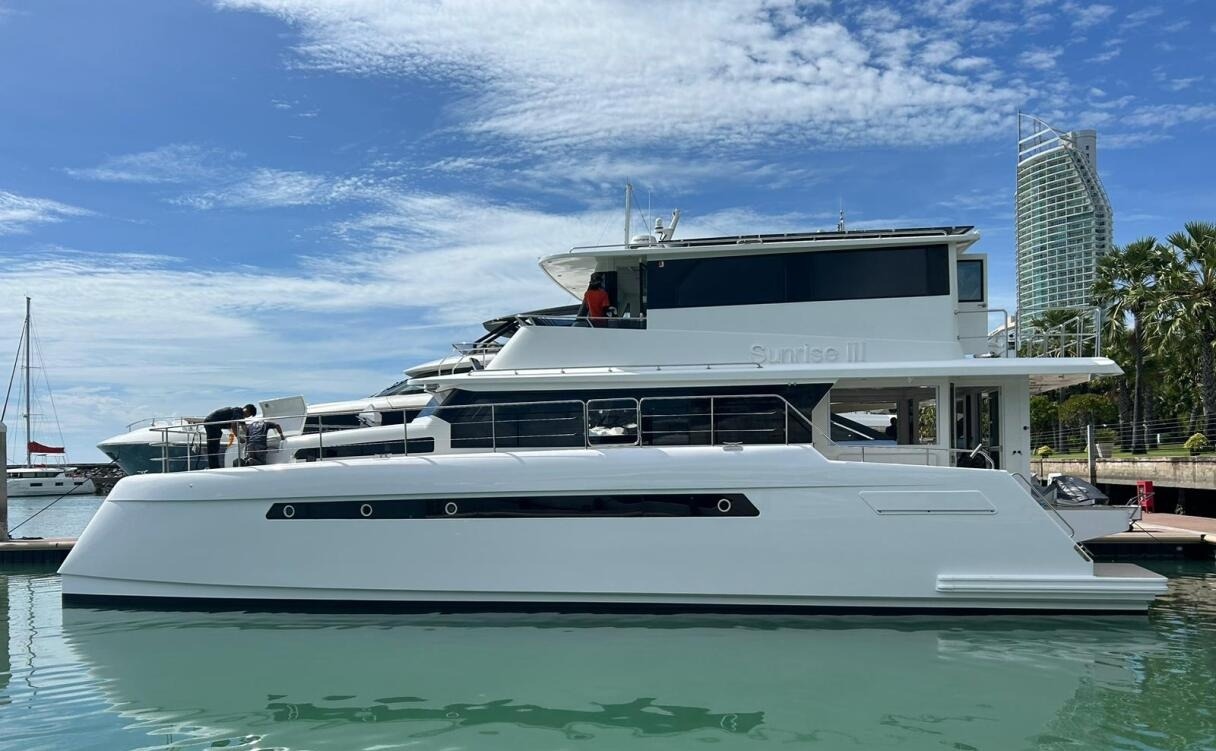
Statistics Can Go Here – Statistics Can Go Here — Statistics Can Go Here – Statistics Can Go Here –
The Longreach Expedition hull features a reverse bow to extend the waterline out as far as possible to maximise efficiency, while also providing a wave piercing effect for a smooth ride at speed. The chines at the waterline ensure a dry boat, while under the waterline the hull features two docking keels to enable safe beaching while also protecting the running gear. The hull is a full displacement hull but designed to motor at cruise speeds of 12 knots, or top speeds of around 25 knots. The Expedition comes standard with long range tanks totalling up to 5,600 litres of diesel providing more than 2,000 miles range at 11.5 knots and a top speed of 20 knots.
Helm & Flybridge
The flybridge is super social, with a massive lounging area, dining table, wet bar with fridge / freezer included. The Expedition features a fully enclosed flybridge with pop-up TV and air-conditioning with dinghy crane on the aft deck
While the helm has twin seats with full support, a full suite of electronics at your fingertips and the wheel and throttle controls from the centre allowing you to stand when berthing. Either side of the helm seats are more lounging seats – people will just gravitate to these areas, plus forward steps to the front deck for easy access to the bow.
Statistics Can Go Here
Saloon, Galley & Cockpit
The Expedition model has a super sized galley forward featuring a steam oven , upright double door fridge, Corian benchtops and high quality fixtures. This galley is accommanied by two breakfast bar style stools, with large lounging area adjacent. Then flows out with opening windows into the cockpit that has the main dining table and lounge with BBQ grill and windows and doors for a breezeway or closed in air-conditioning.
Interior Cabins
The master cabin provides a full king-sized bed with all the room you would be accustomed to in an apartment, with walk in robe and private ensuite with shower & separate fresh water flushing toilet. The starboard side offers a generous Queen bed with large window adjacent and spacious shower, fresh flushing toilet and vanity.
Certificate CE Class A with Lloyds Scantlings
Vessel layout.
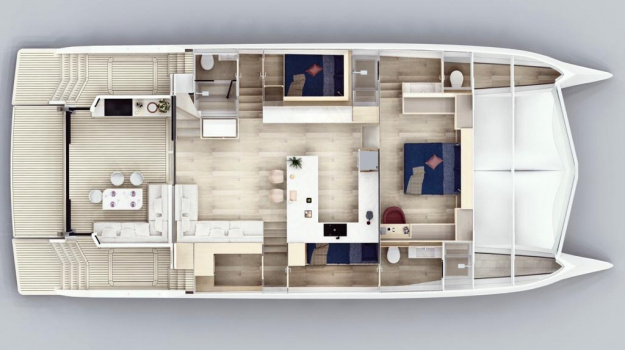
Complete for an info pack or request a guided walk through tour.
" * " indicates required fields
- Who is longreach
- LR1200 500HP
- LR1400 460HP & 500HP
- LR1400 HI-Performance
- Request an Information Pack

13 Best Catamarans for Cruising (Buyer’s Guide With Prices)
As an Amazon Associate, we earn from qualifying purchases. We may also earn commissions if you purchase products from other retailers after clicking on a link from our site.
If you’ve spent many a pleasant weekend chartering or helming a cruising catamaran on the open sea, perhaps, just like me, you’ve started thinking about buying your own cruising catamaran . However, purchasing a cruising catamaran is no small decision; it’s essential to research the range of models to decide which will be best for you.
Some of the best catamarans for cruising are the Sunreef 60, the Leopard 45, the Saona 46, the Manta 42, and the Antares 44i. A good cruising catamaran offers plenty of space, extended range and is optimized for comfort and safety. A cruiser is slower and less exciting to sail than a performance cat.
If you would like to own a catamaran, but your budget doesn’t stretch to purchasing a new one, look for a used, older model. You should also think about whether you’d prefer a power or sailing catamaran. This article explores the best cruising catamarans on the market and gives you an insight into what model will work best for your circumstances.
Are you looking for a specific price range or size? Check out my other articles, such as Best catamarans under 200k or 20 top performance catamarans!
Sunreef 60 (Power/Sail)
The Sunreef 60 is the epitome of luxury. It offers both powerful sailing performance and, with 60 feet (18.3 meters) in length, has an abundance of amenities for passengers.
The Sunreef 60 has been commended by several industry experts, including SailWorld and YachtingWorld . Some of the best features of the Sunreef 60 include :
- A large semi-open saloon that leads into the aft cockpit, the main deck, and the dining space
- An aft hydraulic platform that can be used for water sports and sunbathing
- A large flybridge that can house a pool, bar, and dining area
- An aft garage that can be used as extra storage space
- The ability to host up to 12 guests, with the owner’s cabin offering a spectacular front view
The Sunreef 60’s sailing specifications are equally impressive. Some of the catamaran’s specs include:
Power version:
- An advanced navigation system that allows the Sunreef 60 to operate both with and without a crew
- A fuel capacity of 1585.03 gallons (6000 liters)
- A water capacity of 211.34 gallons (800 liters)
- A draft of 5.90 feet (1.80 meters)
Sail version:
- A fuel capacity of 463 gallons (1750 liters)
- 2*110HP Engines
In 2020, Sunreef launched a variation of the Sunreef 60 – the 60 Sunreef Power Eco . This catamaran is equipped with a state-of-the-art solar power system and wind generators. Eco-responsible finishing materials have been used to construct several parts of the catamaran.
Both the Sunreef 60 and the eco version are excellent sailing crafts built for luxurious, long-distance cruises. They are still in production, so you can order a new vessel from Sunreef 60 . Used Sunreef 60s can be found on TheYachtMarket.com .
As the Sunreef 60 is such a high-end vessel, be prepared to pay a premium price for one – new or used.
Sunreef 60 are priced between $1 488 000 and $2 914 000
Nautitech 47 Power or Nautitech 46 Sail
The Nautitech 47 Power is a sleek power catamaran, designed by Nautitech Catamarans and architected by Marc Lombard.
Catamaran enthusiasts applaud the Nautitech 47 for its short extended hardtop, modern navigation station, and excellent bridge deck clearance . This Nautitech 47 Power has similar attractive features, including:
- A large saloon with a 360-degree panorama
- Optimized hulls and an optimized hardtop
- A comfortable navigation station area that can seat two
- A spacious gallery with large benches for working on
- A generous flybridge and cockpit that provides plenty of room for lounging
- The flybridge can also be enclosed, protecting it from bad weather
- A lifting platform that can be lowered into the water to create a ‘beach’ in the middle of the sea
- Three cabins which can be converted into four depending on how many guests you are entertaining
The Nautitech 47 Power was launched in 2018 and is based on the Nautitech 46 Sail. It employs modern cruising and technical features, including:
- A draft of 3 feet 11 inches (1.20 meters)
- A fuel capacity of 2 x 170 gallons (2 x 645 liters)
- A water tank capacity of 2 x 79 gallons (2 x 300 liters)
- Two Volva Penta engines with a power of 225 HP
Nautitech 46 Sail offers :
- Two Volva Penta engines with a power of 40 HP
- A fuel capacity of 2 x 79 gallons (2 x 300 liters)
The only potential drawback of the Nautitech 47 Power is that it has exposed helms. However, you can fix this with a bimini, which will incur an additional cost.
If you’re interested in buying a Nautitech 47/46, visit NautitechCatamarans.com to find your nearest dealer. The dealer may offer you a sea trial where you can take the catamaran out to sea and judge its performance for yourself. You can also buy a Nautitech second-hand; browse YatchWorld.com to see some options.
Leopard 45 (Sail)
The Leopard 45 is a luxury catamaran that is popular with both charter companies and private owners. Simonis-Voogd designed the external shell while Robertson and Caine did the internal interiors. As its name suggests, the Leopard 45 is 45 feet (13.72 meters) long. It has been recommended by Gregor Tarjan, author of ‘ The Complete Guide for Cruising Sailors ’ and the president of Aeroyacht Ltd.
The Leopard 45 was launched in 2017 and carried forward some of the most popular features and design aspects of earlier Leopard models. For instance, the Leopard 45 has a flybridge lounge which includes space for a seating area, a sunbed, and a table. This feature won an award when it was included in the Leopard 50. Other positive attributes of the Leopard 45 include:
- An increased aft area with floating stairs lead up to the cockpit
- The option to have three or four cabins depending on the number of guests you have
- An open plan saloon and galley, adding to the catamaran’s overall spaciousness
- A protected helm station
- Hardtop lounge in the most recent models
Some of the technical specifications of the Leopard 45 include:
- A minimum draft of 4 feet 11 inches (1.5 meters)
- A bridge deck clearance of 2 feet 9 inches (0.83 meters)
- A freshwater capacity of 206 gallons (780 liters)
- A fuel capacity of 185 gallons (780 liters)
- Two engines with 45 HP each
A new Leopard 45 will be available for purchase directly from Leopard Catamarans in 2022. However, if you can’t wait or want one at a lower price point, consider buying a used one. A range of used Leopard 45s is available on YachtWorld.com .
A Leopard 45 costs between $957 000 – $234 000
Lagoon 440 (Sail)
The Lagoon 440 is a catamaran recognized for its large interior volume, making it a popular catamaran for charter companies. However, the volume also makes it an excellent catamaran for families or owners looking to host large parties. Lagoon also made a power-cat version called the Lagoon 44.
At 44 feet (13.7 meters) long, the Lagoon 440 is relatively heavy. However, it has several functional advantages, including:
- Four cabins with four en-suite heads
- A bimini top
- A cockpit with speakers and a shower that is easily accessible by guests
- A large galley with potential for island top benches
- Lazy jacks and a canvas catchment system that allows for easier sail handling
- Additional storage space in the aft and cockpits
Meanwhile, some of the technical specifications of the Lagoon 440 include:
- A maximum draft of 4.3 feet (1.30 meters)
- One engine capacity with a total power of 54 HP
- Freshwater tanks with a capacity of 237 gallons (897 liters)
- A fuel tank capacity of 172 gallons (651 liters)
While the Lagoon 440 has an excellent collection of features, it does have some drawbacks that users have noted. Some flybridge models of the Lagoon 440 have a high boom position that may make it difficult to access the sail bag. The saloon’s leading edge has a slight squaring, which may be challenging to get aesthetically used to.
Despite these drawbacks, the Lagoon 440 is still a great option if you are on a strict budget. The Lagoon 440 had a six-year production run, where over 400 of the models were produced. As a result, several Lagoon 440s are always available in the second-hand market. Visit YatchtWorld.com to explore catamarans of this model that are currently for sale.
A Lagoon 440 can be purchased at $290 000 – $525 000
Saona 47 (Sail)
Made by Fountaine Pajot, the Saona 47 is a luxury catamaran that is 45.7 feet (13.94 meters) long. Designed by Berret-Racoupeau Yacht Design, it has received several industry and maritime awards, including SAIL magazine’s award for the best multihull cruising boat (40-50 feet).
Launched in April 2017, the Saona 47 is relatively new on the market. As a result, it features a modern design and modern amenities. Some of the most enticing features of the Saona 47 include:
- Several spaces for passengers to lounge and relax, including a large sunbathing area, a lounge deck, and an open plan cockpit
- A lift that can also be converted into a swimming platform
- A large galley with an island bench
- Three cabins, with the master cabin having an en-suite bathroom. If you’re looking to charter it, there is a four-cabin version with space for a crew.
- Good visibility from the helm and the opportunity to engage with other passengers
The Saona 47 also offers an excellent sailing performance. It has a carefully planned weight-to-value ratio, which allows for both speed and stability. Some of the technical features of the Saona 47 are:
- A draft of 4.3 feet (1.3 meters)
- A sail area of 828.8 feet (77 meters)
- A fuel capacity of 2 x 124 gallons (2 x 470 litres)
To buy the Saona 47 new, you can lodge an inquiry on FountainePajot.com . However, you can also visit YachtWorld.com to see if you can find a used Saona 47.
A used Saona 47 may cost between $600,000 – $999,000.
Excess 12 (Sail)
The Excess 12 was launched in 2019 by Groupe Beneteau, the same group which designs Lagoon catamarans. The Excess range has been created for performance-oriented sailing vessels. The catamarans in the range have been applauded for their sailing prowess and their space. The Excess 12 was the first of the range and has been named the best cruising multihull under 40 feet by Sail Magazine.
Designed by VPLP Design, the Excess 12 is considered a ‘sporty’ catamaran. It is 38 feet and 6 inches (11.74 meters). It has an open bimini and a light helm that gives it a feel similar to a monohull. Other attractive features of the Excess 12 include:
- A cockpit with a retractable roof that allows for direct access to sunlight
- The cockpit also has dining space for up to 8 people
- Room for two to three people in the helm
- The option between three or four cabins
- A high aspect rig ratio
- An aft double steering station
- Most areas of the Excess 12 are constructed with cedar and white blend woodwork and united windows, making for a beautiful, natural aesthetic
Reviewers of the Excess 12 note a minor drawback of the twin aft helm. Its location in the corner of the cabin can create a blind spot. Other than this, many of the sailing features of the Excess 12 are positively received. These include:
- A draft of 4 feet and 5 inches (1.35 meters)
- An upwind sail area of 82 meters (269 feet)
- A fuel capacity of 2 x 53 gallons (2 x 200 liters)
- The freshwater capacity of 79 gallons (300 liters)
If you’re interested in buying the Excess 12 new, visit the dealer’s page on ExcessCatamrans.com, or visit YatchtWorld.com to look for a secondhand model.
Manta 42 (Sail)
The Manta 42 is one of the most popular models from Manta, an older brand known for its high-quality catamarans.
The Manta 42 was launched in the late 1990s and was in production until the late 2000s. It received the ‘Best Value Overall’ prize in CW’s 2001 Boat of the Year. Even though it is an older model, it remains a beloved model today and is an excellent option if you are on a tighter budget.
Designed by Eric Lerouge, a French naval architect, the Manta 42 has a variety of attractive features:
- Great sail to area displacement ratio, which makes for smoother sailing
- A spacious aft cockpit area that can be upgraded and customized to suit your own particular design needs
- High bows and curved forward crossbeam make for a streamlined appearance
- Room for three cabins and two heads. The owner’s cabin has its own en-suite bathroom with a large shower.
- Glass-enclosed cockpit
- The interior finish is made with maple and teak wood
Meanwhile, some of the technical and sailing features of the Manta 42 are as follows:
- A draft of 3.8 feet (1.2 meters)
- One engine with a total power of 60 HP
- Two holding tanks with a fuel capacity of 120 gallons (454 liters)
- The freshwater capacity of 100 gallons (379 liters)
If you decide to take the plunge and buy a Manta 42, you will become a member of the Manta Owners Association . This association connects you to other manta owners who offer advice and conversations about Manta maintenance and sailing.
You cannot buy the Manta 42 new. However, there are plenty of used Manta 42 models available on YachtWorld.com .
A used Manta 42 will cost you somewhere between $239 000 – $325 000
Antares 44i (Sail)
The Antares 44i is another older model that offers excellent value for money if you’re working with a lower budget. Its production began in Argentina in the late 2000s. This yacht was built with round-the-world sailing in mind, and it has excellent amenities from both a technical and passenger perspective.
Some of the best passenger facilities the Antares 44i offers are:
- An extended galley with plenty of storage space
- Three cabins, with two at the hulls and one forward cabin on the port side
- Stainless steel arch aft with plenty of space for dinghies
- A cockpit with room for a BBQ and room for lounging
While it is an older model, the Antares 44i still has plenty of modern sailing features and storage room, making it a great long-distance cruiser. Here are some of the attractive technical features:
- A maximum draft of 4 feet (1.2 meters)
- A bridge clearance of 62 feet (18.9 meters)
- Two engines with a total power of 80 HP
- Fuel tanks with a capacity of 120 gallons (454 liters)
- Freshwater tanks with a capacity of 150 gallons (568 liters)
Today, the Antares Catamarans company has built a newer version of the Antares 44i – the Antares 44 , which you can consider if you want to buy a new catamaran. However, the Antares 44i continues to be a great option. You can buy a used Antares 44i on YatchtWorld.com .
Price: $495 000 – $860 000
Catana 50 (Sail)
The Catana 50 is another older model that can hold its own against many more modern cruising catamarans. Like the Antares 44i, it is a more pocket-friendly option that doesn’t compromise sailing quality and passenger amenities.
Catana is one of the world’s best catamaran producers, known for creating stable yet fast boats and for their quality finishes. Besides being produced by Catana, the Catana 50 has been architected by Christophe Barreau, a world class naval architect. Some of the best features that the Catana 50 boasts are:
- A length of 50 feet (15 meters)
- Deep daggerboards allow for excellent windward performance
- Made with carbon fiber which allows for stability and speed
- Hardtop over cockpit
- Twin aft helm stations
- Three cabins which can sleep 6
- Satin oak interior finishes
Meanwhile, the technical specifications of the Catana 50 include:
- A draft of 4 feet (1.2 meters)
- A bridge clearance of 23.7 feet (7 meters)
- Two engines with a total power of 150 HP
- Fuel tanks with a capacity of 227 gallons (860 liters)
- Freshwater tanks with a capacity of 211 gallons (800 liters)
Catana does not produce the Catana 50 anymore. However, you can look for a pre-owned Catana 50 on the CatanaServices website or YatchtWorld.com . There are models of the Catana 50 available for secondhand sale across the world.
A Catana 50 will set you back somewhere between $644 000 – $692 000
Atlantic 42 (Sail)
Like the Manta 42, the Atlantic 42 is a smaller-sized catamaran. It is 42 feet (12.8 meters) long but is spacious and fuel-efficient. It was designed by Chris White , who specializes in designing high-performance catamarans.
The Atlantic 42 was in production in 1999 but boasts many classic features found in modern-day catamarans. The Atlantic 42 has been the recipient of Cruising World magazine’s Boat of the Year award. Noteworthy features in the Atlantic 42 include:
- A high waist and forward cockpit
- Custom aft deck allowing for easy access to the dinghy storage
- Interior design constructed with teak and holly wood
- Navigation station with space for two seats
- A secure, raised pilothouse that allows for excellent visibility in stormy weather
- A galley with enough space for long-distance cruises
- Two double cabins and two single cabins
In addition to good passenger amenities, the Atlantic 42 has some excellent sailing specifications, including:
- Water capacity of 80 gallons (302.8 liters)
- Fuel capacity of 80 gallons (302.8 liters)
- A bridge deck clearance of 62 feet (18.9 meters)
- Engines with a total power of 58 HO
The Atlantic 42 is no longer in production but can be custom ordered from Chris White designs . However, they can also be found on resale platforms such as YacthtWorld.com .
Price: $325 000 – $450 000
Seawind 1160 (Sail)
The Seawind 1160 is a long-distance cruiser produced by Seawind Catamarans , a leading catamaran manufacturer designing and building catamarans for over 35 years.
This catamaran is available in two styles : the lite Seawind 1160 and the deluxe Seawind 1160. The deluxe catamaran operates with diesel sail drives that allow for excellent torque and fuel capacity. Meanwhile, the lite version works with outboard motors that reduce the catamaran’s overall weight. It also has more storage internally on the boat, and lower maintenance and replacement costs.
The Seawind 1160 has won Cruising World’s ‘Most Innovative Boat’ award in 2007. It won this award thanks to its tri-folding door, which opens the saloon and the cockpit to form a living or lounging area. Other significant design aspects and passenger amenities include:
- Twin helm stations
- 360-degree visibility from the cockpit
- Grey wash and timber interior to make for a highly modern interior
- Three cabins in the owner’s version of the catamaran with a queen-sized bed in the master cabin
- Hulls made of fiberglass
Meanwhile, the sailing and design specifications of the Seawind 1160 are as follows:
- A diesel fuel capacity of 95 US gallons (360 liters)
- A freshwater capacity of 185 US gallons (700 liters)
- A draft of 3 feet and six inches (1.1 meters)
To buy a Seawind 1160 new, you can lodge an inquiry with SeaWindCats.com . However, you can also look for secondhand Seawind 1160s on websites like MultihullCentral.com .
Price: $230 000 – $460 000
Bahia 46 (Sail)
Produced by Fountaine Pajot, the Bahia 46 has a sophisticated design that makes it an excellent choice. The Bahia 46 was also designed in conjunction with Joubert-Nivelt and Oliver Flahault.
Some of the stand out features of the Bahia 46 include:
- Larger than usual hulls
- Daggerboards are strategically placed to minimize draft
- A six post-bimini that can hold dinghies
- Isolated engines that prevent passengers from being disturbed by the house and smell of the engines
- Generous cabin area with an enclosed space that provides protection from severe weather
- A large cockpit with a dining space that can seat 10
As well as offering excellent passenger and design amenities, the Bahia 46 has some attractive sailing features and specifications. These include:
- A draft of 4 feet 3 inches (1.30 meters)
- A fuel capacity of 100 gallons (378 liters)
- A freshwater capacity of 220 gallons (833 liters)
- Two engines with a total power of 80 HP
The Bahia 46 is no longer being produced. However, you can look to buy it secondhand on portals like YatchtWorld.com or SailTahiti.com .
Price: $170 000 – $328 000
Aquila 48 (Power)
The Aquila 48 is a state-of-the-art power catamaran. While production of the Aquila 48 was discontinued in 2020, it is still an incredibly popular catamaran in the resale market.
The ambient and design features of the Aquila 48 include:
- A hardtop flybridge made with stainless steel and with air conditioning
- A forward cockpit with a removable table
- The choice between a four or three-cabin version
- A helm station with a canvas cover that offers weather protection
- An expansive galley with room for a range of facilities, including a microwave, a fridge, and a double sink
- Interiors finished with olive wood
The Aquila 48 is a power catamaran that allows for easy, stable, and fast cruising. Other specifications include:
- A maximum draft of 3 feet (0.91 meters)
- Two engines with a maximum of 330 HP
- A freshwater capacity of 103 gallons (389.9 liters)
- Fuel tank capacity of 178 gallons (673.8 liters)
You can buy the Aquila 48 second hand on websites like SiYachts.com or YatchtWorld.com .
Price: $550 000 – $699 000
Conclusion
Depending on your budget and sailing style, there is a range of cruising catamarans you can choose from. Some of the best power catamarans include the Aquila 48, Sunreef Power, and Nautitech 47 Power. Meanwhile, some of the best luxury catamarans are the Saona 47 and Leopard 45. If you’re after an older catamaran that you can buy secondhand, the Manta 42, Antares 44i, and Lagoon 440 are excellent options .
The next step in your catamaran journey is to see some of the models in their real-life glory. Contact some of the owners or dealers of these catamarans to see the catamarans up close and take them out for a trial!
- AntaresCatamarans: Antares Brand
- Catana Services: Pre Owned Boats
- CruisersForum: Nautitech 47
- Chris White: Atlantic 42 Catamaran
- CrusingWorld: 40 Best Cruising Catamarans
- Excess Catamarans: Excess 12
- FlagstaffMarine: International Awards and Nominations for 2020
- Flagstaff Marine: Excess 12
- Fountaine Pajot: Saona 47
- Leopard Catamarans: Model Availability
- MantaOwners: Manta Owners Association
- Multihull Solutions: Award Winning Catamarans
- Multihull Central: Seawind 1160
- Nautitech Catamarans: Nautitech 47
- Robertson and Caine: Leopard 45
- SailTahiti: Catana 50
- Sail Magazine: 10 Great Cruising Cat
- Sail Magazine: Boat Review – Fountaine Pajot Saona 47
- SailWorld: 60 Sunreef Power
- Seawind Catamarans: History
- Staten Island Yacht Sales: Aquila 48
- Sunreef Yachts: Eco Sunreef 60 Power
- Sunreef Yachts: Sunreef 60
- YachtingWorld: The Sunreef 60
- YachtWorld: Antares Boats for Sale
- YachtWorld: Atlantic 42
- YachtWorld: Catana 50 for Sale
- YachtWorld: Nautitech 47 Boats for Sale
- YachtWorld: Leopard 45 for Sale
- YachtWorld: Lagoon 440 for Sale
- YachtWorld: Saona 47 for Sale
- YachtWorld: Excess 12
- YachtWorld: Fountaine Pajot for Sale
- YachtWorld: Aquila 48
- YachtWorld: Manta 42 Boats for Sale
Owner of CatamaranFreedom.com. A minimalist that has lived in a caravan in Sweden, 35ft Monohull in the Bahamas, and right now in his self-built Van. He just started the next adventure, to circumnavigate the world on a Catamaran!
Leave a Reply Cancel reply
Your email address will not be published. Required fields are marked *
Save my name and email in this browser for the next time I comment.
Recent Posts
Must-Have Boat Gear for Catamaran Sailors!
Sailing is probably the most gear-intensive activity I've ever done; there are so many decisions to be made about what gear to buy now, for tomorrow, and what to definitely never buy. The gear on...
6 Best Trailerable Trimarans For Bluewater and Coastal Sailing
Having a boat costs a lot of money, even when you are not using it, marina fees, etc. And once it is in the water most sailors never go very far from their "home marina" and sailing will be somewhat...
The C100 has a roomy cockpit that’s the ideal multifunction space, transitioning from welcoming aboard guests for a fun day on the water or spending the day fishing.
The C100 Escape has a comfortable salon area with galley to port and a dinette to starboard.
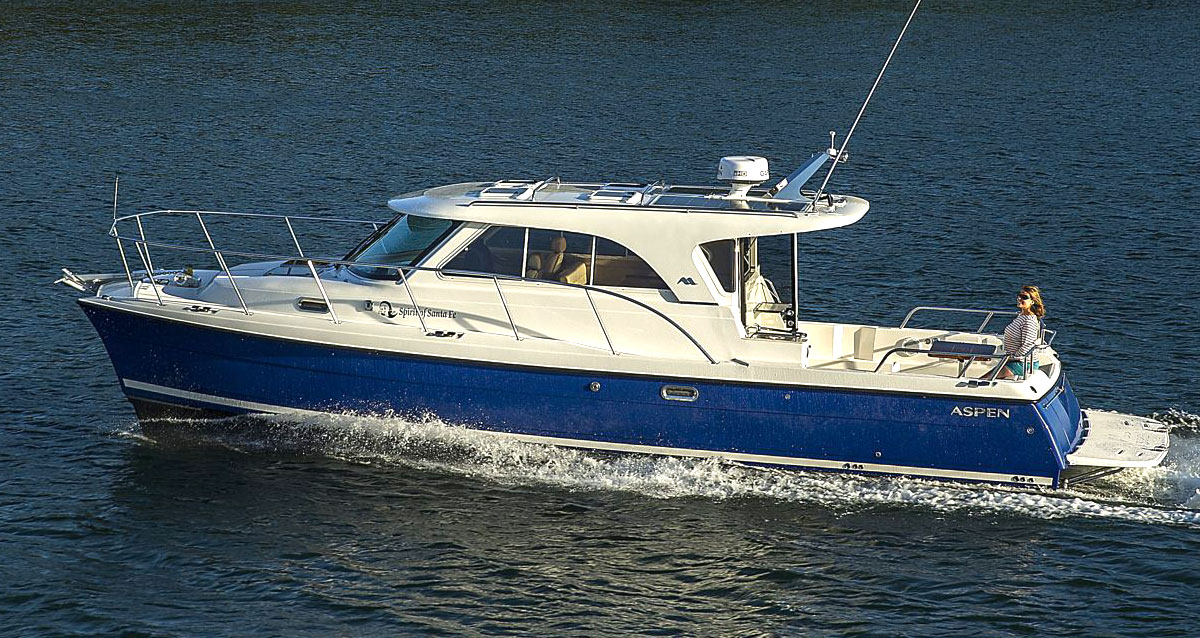
The dinette seats four and converts to a double berth, while the galley is equipped with a propane stove, oven, and a refrigerator. Accommodations include a master forward with a king-size berth, and a separate enclosed head with shower, and there’s a quarter-berth beneath the galley. The 220-horsepower Volvo Penta D3 is mounted just abaft the salon bulkhead and reduces noise levels to make the C100 exceptionally quiet under way. The spacious cockpit is designed for fishing or entertaining with standard features including a refrigerator and a sink, a built-in, 96-quart Igloo cooler with a large seat, and generous stowage in port and starboard lazarettes. The C100 hull is special, designed with substantial buoyancy that adds travel to the boat’s suspension system for large-sea passage-making. C100 owners are set to make weeklong adventure trips, island to island, or cruise vast open coastlines with speed, comfort, and efficiency.
KEY SPECIFICATIONS
Take a Tour of the C100 in This Video
FULL SPECIFICATIONS
- LOA w/step: 34’ 8”
- Draft 1/2 Tanks: 10’
- Est. Dry Weight: 8,400 lb.
- Standard HP, Volvo D3: 220
- Fuel: 80 gal.
- Fuel Optional: 120 gal.
- Range at 18mph: 248/372 miles
- Trolling Range: 1,100/1,650 miles
- Cockpit: 69 sq.ft.
- Water Tank: 50 gal.
- Waste Tank: 30 gal.
- Master Stateroom: King
- Bridge Clearance, Mast Down, in water: 8’ 2”
- Bridge Clearance, Mast Down, on trailer: 12’ 8”

Download the equipment and price list for the Aspen C100
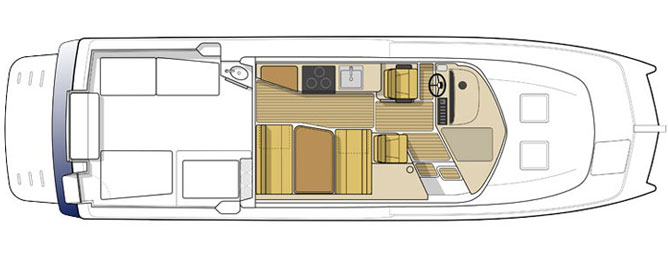
Performance of The Aspen C100
Volvo D3 – 220hp | 10,420lbs. | March 2, 2013
W/ 10% Reserves
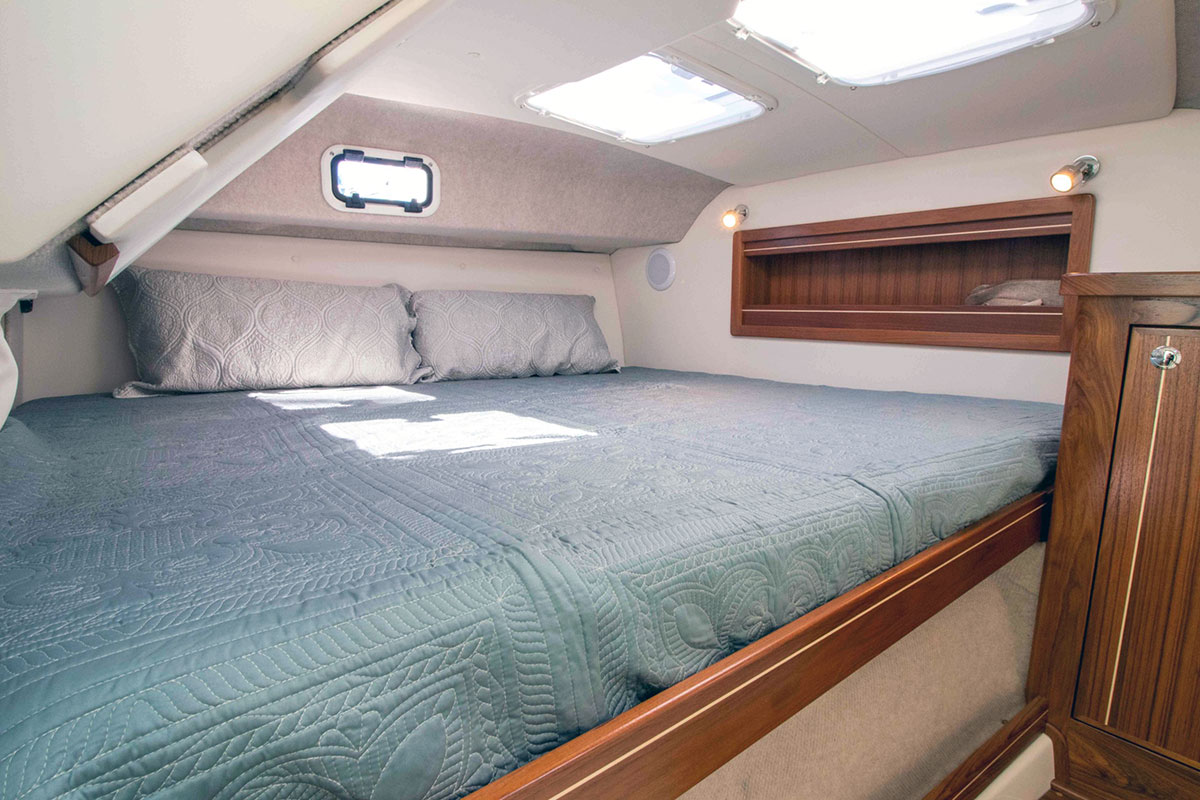
Patent No. US 8,109,221 B2
Stay Up to Date with Aspen Sign up to receive our enewsletter.
11656 Knudson Rd. Burlington, WA 98233
Privacy Policy
© Copyright 2012 - 2024 | Aspen Power Catamarans
(360) 668-4347 EMAIL US
West Coast Multihulls
West Coast Multihulls 955 Harbor Island Drive Suite 180 San Diego, CA 92101 619.571.3513
- Name: * E-mail: * Message: *
- Boat Search
- Vessel Type : Any New Sail Used-Brokerage Sail New Power Used-Brokerage Power
- Length Overall : -
- Hull Form : Any Catamaran Trimaran Monohull

- ALL Catamarans
- New Catamarans
- Used Catamarans
- Catamaran Shared Ownership
- Full Event Listings
- Multihull vs Monohull
- San Diego Catamaran Charters
- Sea of Cortez Catamaran Charters
- Multihull Sailing Lessons
- San Diego Sailing Events
- The WCM Approach
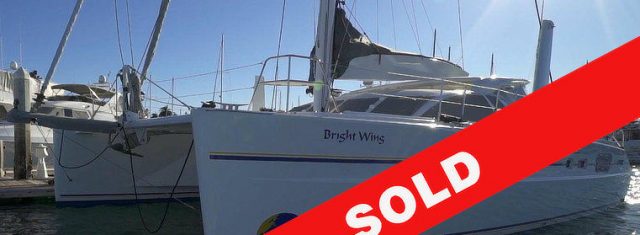
Meticulously Maintained Catana 52 Catamaran
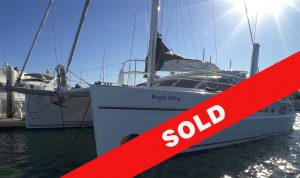
Helm And Cockpit
- Manual wheel steering with Lewmar Rotary Sprocket drives
- Cockpit engine controls
- Teak decks in cockpit
- Large dining table with L Shaped Seating
- Cockpit settees have adjustable recliners on port and starboard
- Large storage areas below cockpit floor
- Dodger, bimini, fully enclosed cockpit with Lexan panels Cockpit cushions with upgraded foam (2018, like new)
- Two deep storage lockers forward in each bow and abundance of storage below cockpit sole
- lifelines and stanchions
- Boarding gates
- Dock lines and fenders
- Swim ladder
- Swim platform
- Bow pulpit seats port and starboard
- Spectra trampolines
- Tent-like shade cover for trampolines
- Line organizers and stowage for all halyards, reef lines and sheets
Sails, Rigging And Hardware
- Rod standing rigging (replaced 2019)
- Carbon fiber mast by Alucarbon, deck-stepped on ball and socket (Stripped and painted in 2019)
- Carbon canoe boom
- Harken solent traveler
- Profurl furling system on both headsail and solent
- Electric windlass remote at starboard helm
- (1) Harken 60 self-tailing electric main halyard and reefing line winch
- (2) Harken 60 self-tailing electric Genoa winches
- (2) Harken 48 self-tailing mainsheet winches
- (2) Harken 48 self-tailing spinnaker sheet winches
- (2) Harken 48 self-tailing daggerboard winches
- (1) Lewmar 48 self-tailing headsail halyard winch
- (1) Harken 48 self-tailing on mast with (3) halyard spinlocks All winches serviced in 2021
- 2019 North 3Di fully battened mainsail with Harken Battcar system
- 388 sq ft self-tacking Solent jib; Dacron with Sunbrella UV protection (little used)
- 130% Genoa (original)
- (1) carbon screacher
- (1) Kevlar screacher with UV Protections
- 3/4 oz. asymmetrical spinnaker
- 1.5 oz. symmetrical spinnaker
- 2:1 ratio Dyneema main halyard (new 2018)
- Reef lines, halyards and spectra lazy jacks all new (2019)
- All halyards and lines lead beneath deck creating clean and spacious uncluttered deck space
Accommodations
Port Aft Cabin Two twin beds with a filler to make a king-size bed, wall-mounted TV, shelves inboard and hanging locker outboard, 2 fans, reading lights, AC outlets, and air conditioning controls.
Port Passageway Washer/Dryer outboard, linen cabinet with shelves inboard and entrance to enclosed head with shower.
Port Forward Cabin Queen size berth with steps, storage bins outboard, cabinets overhead, 2 large cabinets with shelves inboard and outboard, 2 fans, reading lights, AC outlets, and air conditioning controls.
Starboard Forward Cabin Queen size berth with steps, storage bins outboard, cabinets overhead, 2 large cabinets with shelves, 2 fans, reading lights, AC outlets, and air conditioning controls. Starboard Passageway Large hanging locker with shelves above and the entrance to the enclosed head with shower.
Starboard Aft Cabin Queen Size Berth with step, large cabinet with shelving outboard, large hanging locker inboard, B&G Multifunction Display, 2 fans, reading lights, AC outlets, and air conditioning controls.
- Counter was customized to be wider
- Custom spice drawer, shot glass rack and knife holder
- Refrigerator – Frigoboat 24V stainless steel side by side on starboard side
- Stainless steel freezer
- 3-burner Barazza stainless steel propane stove with Airlux oven
- Tappan microwave
- U-Line icemaker (2016)
- 2 stainless steel sinks side by side
Navigation And Electronics
- All electronics new 2019
- B&G Zeus wind speed and direction
- B&G Zeus speed and distance logs
- B&G Zeus fishfinder
- (2) Simrad autopilots with totally separate drive units
- (2) Plastimo 5” pedestal compasses
- B&G Zeus GPS
- B&G Zeus chart plotter
- B&G radar and mount (new 2019)
- Icom VHF radio
- Icom SSB radio
- KVH 3IP sat com wired for Sirius radio
- Chelsea barometer
- Sat Phone with CPU
- Simrad rudder angle indicator
- Wilson cell phone booster at masthead
- 40” Samsung flat screen TV on custom swivel mount so that TV can be seen from either the salon or the cockpit
- Zeus system has 24” screen at nav station, 12” screen at each helm and (2) multi-function displays on bulkhead (port and starboard) and a multi-function display in each aft stateroom with remote at each helm
- TV in each aft cabin
- Marantz AV receiver with woofer and Sony Bluetooth speakers for total surround sound
- Northern Lights 8kW generator (1590 hours) with separate 100-gal polyethanol fuel tank
- 12V DC, 110V AC and 220V AC
- Around the World kit with outlets 2x110V and 220V
- (12) Fullriver DC 400-6 Group L16 6V house batteries (2021)
- Lifeline AGM 12V engine start battery
- Legend Premium 12V engine start battery
- Optima Bluetop 12V generator start battery
- Centaur 24V 50A battery charger
- Xantrex Charge Load Controller
- Victorian Energy inverter/charger, AC transfer capacity 50A/120V
- (6) solar panels
- 50 Amp shore power cord
Engine And Mechanical
- Fresh water-cooled engine
- 3-blade Flexo-Fold folding prop
- Emergency engine stop
- Engine fuel Shut Off Valve
- Engine alarm
- (3) Racor fuel filters
- (3) raw water sea strainers
- Thermal and acoustic engine area insulation
- Forced ventilation in both engine compartmentsCustom exhaust risers and new heat exchangers (2019)
- (2) 250-gal fuel tanks custom fiber/elastomer bladder tanks by ATL (new 2017)
Water System
- Spectra Newport 1000 Watermaker (41 gallons/hr with autoflush)
- Hot & Cold Pressure water system
- 2 Water Heaters (8 gallon-110V and engine driven)(2) 105-gal water tanks – all water ever put in tanks has been filtered thru a filter with UV treatment
- Freshwater & Saltwater Deck Wash
- (2) Electric Bilge Pumps
- (2) Electric Sump Pumps
- (6) life jackets
- (2) fire extinguishers
- Viking 8-man life raft (serviced 2021)
- (3) Jim Buoy throwable horseshoe lifesaving devices
- (2) Radar Reflectors
- Bell and horn
- Emergency tiller
- Parachute drogue with 300’ 1” double braided line with Fast Pack
- MOB button at each helm and nav station
- 2) VacuFlush heads (new 2017, rebuilt 2019)
- 2) 28-gal holding tanks
Anchors And Windlass
- 110# Delta anchor with 250’ 3/8” high test chain and rode
- 65# G-125 Fortress anchor with chain and rode
- 45# Manson Supreme as third anchor
- 13# Fortress G-23 stern anchor with chain and rode
- Maxwell Liberty 2500 vertical electric windlass with manual backup and remote control at starboard helm
Dinghy And Davits
- 12’ AB Fiberglass bottom Deep-V RIB
- 20hp 4-stroke Honda outboard
- Davits with SUP Racks
- Webasto 2004 Series 30,000 Btu air conditioning with twin compressors (fancoils 1×16,000 Btu in salon: 4×4000 Btu in staterooms)
- Splendide clothes washer/dryer in port hull
- Custom exhaust risers and new heat exchangers (2021)
- Magma Propane BBQ
- SUP Racks on port and starboard
- Location : San Diego, California USA
- Price : $659,000
- Year Built : 2009
- Brand/Builder : Catana
- Model Name : 52
- Hull Form : Catamaran
- Hull Material : Fiberglass/GRP
- Boat Name : Bright Wing
- Flagged : USA
- Length Overall : 51.7
- Beam : 28.2
- Draft : 4.2
- Displacement : 44000
- Mainsail Area : 1065
- Propulsion : Twin Diesel
- Total HP : 156
- Fuel Capacity : 500
- Fresh Water : 105
- Waste : 28
- Dinghy : 12 ft RIB w/20 hp Honda 4-Stroke
- Phone Number : Kurt: 619.571.3513
- Vessel Type : Used-Brokerage Sail
Denison Yacht Sales/West Coast Multihulls offers the details of this yacht in good faith but cannot guarantee or warrant the accuracy of this information nor warrant the condition of this boat for sale. A yacht buyer should instruct his yacht broker, or his boat surveyors, to investigate such details as the buyer desires validated. This yacht for sale is offered subject to prior sale, price change, or withdrawal without notice.
Refine Your Search
Full gallery.
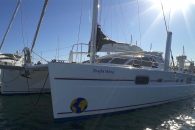
- Your Source for EVERYTHING Multihull!
- Catamarans for Sale
- Contact West Coast Multihulls
- Multihull vs Monohull: Advantages
- Other Catamarans for Sale
- Sailing in San Diego: Charters & Lessons
- Submit a Testimonial
- Boat Sales: 619.571.3513 Lessons/Charters: 619.365.4326
- Your Source for Catamarans and Trimarans

- Copyright © 2008-2016, West Coast Multihulls
- The Denali theme by Usability Dynamics, Inc.
- 33′ Open Fisherman
- 36′ Open Fisherman
- 39′ Open Fisherman
- 43′ Open Fisherman
- 33′ Catamaran
- 35′ Catamaran
- 37’ Catamaran
- 40’ Catamaran
- 46’ Catamaran
46’ Pilothouse
- Defined by Our Differences
- Brand Ambassadors
- Boat Shows And Events
- Warranty and Facilities
- International
- Find a Dealer Near You
- Build an invincible
- Build an Invincible
- DEFINED BY OUR DIFFERENCES
- OUR INTERNATIONAL TEAM
- INVINCIBLE WORLDWIDE
- FIND A DEALER
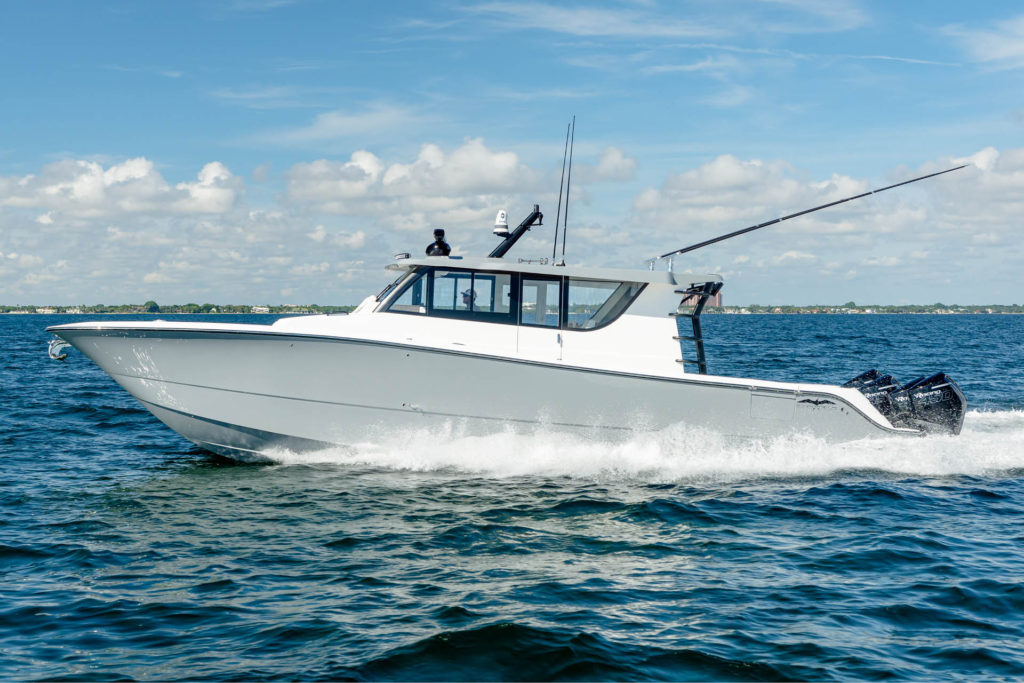
The game hasn’t just changed, it’s been revolutionized.
With the introduction of the 46’ Catamaran in 2020, it raised the cat segment to a whole new level. Now we’ve upped the stakes again by unveiling the first-ever production pilothouse catamaran. Offering the same range, performance and 360-degree fishability of the center console 46’ Catamaran, but equipped with the sleeping space and comfort of a comparably-sized sportfish. Introducing the 46’ Pilothouse: the new pinnacle of innovation
Specifications
Length overall, dead rise at transom, weight with power*, standard fuel capacity.
1,000 GALLONS
3,785 LITRES
Maximum Horsepower
*weight is listed as “ready to fish” which indicates full fuel and livewells..

Insulated Fish Box
Anchor Locker
Bilge Access
Photo Gallery
Highlighted features.
- Enclosed Pilothouse
- 360-Degree Fishability
- Patented Catamaran Hull Design
STANDARD FEATURES
- Air Conditioning
- Finished Bilge
- Above and Below Deck Livewells
- AGM Sealed Batteries
- Built-In Anchor Locker
- Under Gunnel Lighting
- High-Speed Pickup for Livewell Seachest
- Interior Console Lighting
- Saltwater Washdown
- Three Automatic 2,000 GPH Bilge Pumps
- Waterproof Switches and Circuit Breaker
- Protected System
- 100% Vinylester Resin Hull
- 316 Stainless-Steel Hardware
- Vacuum-Bagged Cored Hull Construction
POWER OPTIONS
- Quadruple 400 Mercury Verado
- Quadruple 425 Yamaha XTO
- Quadruple 450R Mercury Racing (5.44”)
CUSTOM TOP OPTIONS
- Pilothouse Hardtop
- Center Console Extended Hardtop
- Rear Entry Tower w/ Dual Station
- Hard Buggy Top Upgrade
- LED Spreader Lights (each)
- Rupp Top Gun Revolution Outriggers
- Rupp Carbon Fiber Outrigger Upgrade
- Gem Deluxe Outriggers w/ Carbon Fiber Poles
- Gem 22′ Outrigger Upgrade (pair)
- Single Rod Rack for Hardtop (5)
- Kingfish Rodholders (pair)
- Full Pilothouse Glass Windshield
- Double Rod Rack Upgrade (needs rear support)
- Tigress Electric Outriggers w/ Gemlux Poles
FISHING ACCESSORY OPTIONS
- Rod Holders on Side of Gunwale Additional (each)
- Rod Holders on Console Vertical (each)
- Rod Holders on Coffin Box (each)
- Heavy Duty Swivel Rod Holders (each)
- Livewell Seachest 2 pumps
- Livewell Seachest 3 pumps
- Livewell Seachest 4 pumps
- Large Livewell Seachest 6 pumps
- Additional High Speed Pickup
- Above Deck Livewell Connections (each)
- Clear Plexiglass Lid for Livewell (Floor Well)
- Under Gunnel Rod Racks (each)
- Under Gunnel Gaff Holders (each)
- Electric Reel Outlets (each)
- Colored Livewell (each)
- Livewell Light (each)
- Built-in Tuna Tube Upgrade (each)
- In Floor Livewell – 70 gallons (each)
SEATING OPTIONS
- 4 Helm Chairs & Small Rear U-Shape
- 2 Helm Chairs & Large Rear U-Shape
- ShoXS Pedestals (per helm chair)
- U-Shape Table (requires large U-Shape)
- Cockpit Rear Mezzanine Seat
- Cockpit Rear Prep Station
- Leaning Post Chill Plate
- Front Fold-Out Storage Lockers
- Rear Fold-Out Jump Seats
ENHANCEMENT AND CONVENIENCE
- Fancy Rigid Rubrail with Stainless Insert
- Hull Side Dive Door w/ Ladder
- Dive Ladder – Transom Pullout Style
- Fresh Water Washdown
- Hose Coil Kits for Fresh and Salt Washdowns
- Additional Hose Coil Kit for Salt Washdown
- Additional Hose Coil Kit for Fresh Washdown
- Deluxe Electric Head in Console
- Windlass in Hull w/ Custom Anchor and Bracket
- SS Towing Eye Strike Plate Package
- Under Water Lights LED – Blue & White (each)
- PC1800 Battery System Upgrade
- Battery Charger with Galvanic Isolator
- Stainless Steel Cupholders on Gunwale (each)
- Ultra Junior Float Switch Upgrade (each)
- Upper Console Keeper
COLORS AND CANVAS OPTIONS
- Custom One Color Gelcoat for Hull
- Full Coaming Bolsters
COVER AND SHADE OPTIONS
- Forward Bahama Shade
- Aft Bahama Shade
- Motor Cover (each)
- Second Station Box Cover
- NEW : Our Second-Hand catamarans
- New Windelo 50 Adventure
- New Windelo 50 Yachting
- New Windelo 50 Sport
- New Windelo 54 Adventure
- New Windelo 54 Yachting
- New Windelo 54 Sport
- Our Second-Hand catamarans
- The Windelo Innovations : performant, comfortable and eco-friendly catamarans
- Ocean Future : our ecological approach
- The Windelo Services
- Charter a Windelo catamaran
- The Windelo Shipyard
- Windelo Team
- Recruitment : Join the Windelo team

FORWARD COCKPIT Two steering wheels protected from the wind and spray
Located just aft of the mast, the forward cockpit has two steering wheels protected from the wind and spray and a good view of the sails and the bows. All the running rigging is at your fingertips, so the need to move about on deck is limited.
The Windelo cockpit opens onto the saloon and its design is central to sailing the boat and life together on board. With fully centralized controls, better visibility, and optimal comfort, Windelo sailors can fully enjoy safe sailing with no concession to performance .
The forward cockpit caters to the desire for a comfortable social space for the entire crew, the skipper, and the passengers. Our innovation also reflects Windelo’s team effort to build a more practical catamaran offering better visibility and greater safety.

A comfortable, spacious, practical cockpit
The forward cockpit has a clear view of the sea. It can be closed off completely to protect the helmsman from the elements. The forward cockpit’s fixed and sliding openings (side, ceiling, and front) offer an excellent view of the bows, sails, rigging, and the catamaran’s foredeck.
On top of this, the Windelo cockpit keeps the skipper completely safe, successfully protecting them from spray and enabling them to anticipate any sailing problems with ease.
From a practical perspective, access to the cockpit is either from the stern through the saloon or at the bow from the deck.
You will love the interior, since all the running rigging, sailing instruments, and catamaran controls are centralized and divided among, the 2 helm stations to starboard and port.
The multifunction display with its navigation features as well as the boat’s entire management system are located to starboard. The foresail sheets (gennaker, code 0, code 3) and the starboard daggerboard control are also located here. On the right hand, the engine controls facilitate maneuvering.
The foresails and self-tacking solent sheets and the port daggerboard control are located on the port side. Two repeater displays show the wind direction, speed, and autopilot controls.
The mainsail sheet and halyard are positioned on the central winch. The same is true of the furling leads.
Lastly, the electric windlass is built into the forward cockpit, making mooring maneuvering a lot easier.
We have done our utmost to design a comfortable catamaran that can be sailed safely solo, short-handed, or with a crew.
Comfort in good company
The cockpit is modern and innovative, opening onto the saloon through completely watertight doors. The space offers unrivaled comfort and makes social interaction between the skipper and the crew a lot easier. You have to admit that exploring the seas in good company is one of sailing’s true pleasures.

A resounding architectural success
Windelo has successfully built a comfortable, high-performance, ecological , people-friendly catamaran. By bringing all the navigation and boat controls into the cockpit, we have succeeded in modulating the spac e in a new way, improving the whole crew’s safety and offering true pleasure at the helm.
The space offers unrivaled comfort and makes social interaction between the skipper and the crew a lot easier.

SALES MANAGER
Windelo is a new conception brand of innovative catamarans. Ecology is at the heart of the company with the ambition to significantly reduce the environmental impact of our boats. A range of 44 to 60 foot catamarans offering sailors the opportunity to sail with pleasure and safety on eco-friendly boats.
In full development, we are hiring a sales manager:
JOB AND MISSIONS: Managed by the director of the company, and in connection with our various services and partners, you are a key player in the launch of this new brand.
Real project manager: 1. You co-build the Windelo sales and services office, 2. You recruit, train, and drive progressively a team of passionate experts, 3. You develop and innovate in the strategy of selling Windelo boats in Europe, 4. You recruit and lead a global network of sales partners, 5. You co-build and animate the company’s service strategy: port mapping places; insurance and financing; training; owner’s manual etc.
YOUR PROFIL 1. Passionate about sailing, you practice regularly, 2. Your sense of service and customer leads you to satisfy your customers every day, 3. You are enthusiastic and motivated to work in a start-up, 4. You have 2 to 5 years’ experience in the sale of boats, 5. Bilingual French – English, you also speak a third language: German, Italian, or Spanish.
EVOLUTIVE JOB Director of sales
AVAILABILITY / PLACE OF WORK 1st Quarter 2019 / Occitanie Region, Canet en Roussillon FRANCE
TYPE OF CONTRACT AND REMUNERATION Permanent contract / fixed to be defined according to experience + variable.
If you are a passionate of sailing and this challenge to participate in the development of a company in full creation arouses your enthusiasm, welcome to send your application by e-mail to: contact@windelo-catamaran.com
RESPONSABLE DES VENTES
Windelo consiste en la création d’une nouvelle marque de catamarans innovants. L’écologie est au coeur de l’entreprise avec pour ambition de réduire fortement l’impact environnemental de nos bateaux. Une gamme de catamarans de 44 à 60 pieds offrant aux marins la possibilité de naviguer avec plaisir et sécurité sur des bateaux éco responsables.
En plein développement, nous recrutons un(e) responsable des ventes
POSTE ET MISSIONS
Managé(e) par le directeur de l’entreprise, et en lien avec nos différents services et partenaires, vous êtes un acteur clefs du lancement de cette nouvelle marque. Véritable chef de projet :
1. Vous co-construisez le bureau des ventes et des services de Windelo, 2. Vous recrutez, formez, et animez progressivement une équipe d’experts passionnés, 3. Vous développez et innovez dans la stratégie de vente des bateaux Windelo en Europe, 4. Vous recrutez et animez un réseau mondial de partenaires de vente, 5. Vous co-construisez et animez la stratégie de service de l’entreprise : mapping des places de port ; assurance et financement ; formation ; entretien ; manuel du propriétaire etc.
VOTRE PROFIL 1. Passionné(e) de nautisme, vous naviguez régulièrement, 2. Votre sens du service et du client vous anime pour satisfaire vos clients au quotidien, 3. Vous êtes enthousiaste et motivé(e) à l’idée de travailler en équipe dans une « start-up », 4. Vous disposez de 2 à 5 ans d’expérience dans la vente de bateaux de plaisance, 5. Bilingue français – anglais, vous maitrisez également une troisième langue : allemand, italien, ou espagnol.
POSTE EVOLUTIF Directeur des ventes
DISPONIBILITÉ / LIEU DE TRAVAIL 1ier Trimestre 2019 / Région Occitanie, Canet en Roussillon FRANCE
TYPE DE CONTRAT ET REMUNERATION CDI Cadre / Fixe à définir selon expérience + variable.
Si vous êtes un(e) passionné(e) de l’univers du nautisme et que ce challenge de participer au développement d’une entreprise en pleine création suscite votre enthousiasme, merci d’adresser votre candidature par e-mail à : contact@windelo-catamaran.com
As part of the creation of new types of catamaran made in Occitanie, an audacious choice of ecological innovation has been selected in partnership with the Materials Center of « Mines d’Alès » (C2MA – IMT MINES ALES) (Gard, France). It’s a question of combining ecological performance in terms of minimizing the environmental footprint and structural resistance, and this, in a global approach of circular economy on all parts of the boat. To do this, and in connection with the IMT MINES ALES, Windelo has relied on the use of secondary raw materials, competitive virgin petroleum-based materials, that fully comply with the specifications in terms of mechanical performance. This is a real first step to the development of a 2.0 fleet ships fully integrated into the challenges and ecological challenges of the 21st century.
Associated with an ecological approach of circular economy integrating a not insignificant part of competitive secondary raw materials from virgin materials, the architectural design and the resistance of materials on the new Windelo catamarans are mechanically tested in the Materials Center of « Mines d’Alès » (C2MA – IMT MINES ALES) (Gard, France) in connection with the architects and designers of the project. The design of the ship, and in particular the hulls and bows, go through a search for efficient structuring and arranging of materials composing it, combined with a mechanically optimized geometrical assembly. To this end, specific test developments, such as the study of distortion of the structure and of the panels constituating the hull of the ship, are studied by digital image correlation techniques coupled with standardized strength tests.
Founder of Catana
“The cruising program for this new boat raises the question of the antagonism between the search for performance under sail and the pleasure of navigation, and the development of pleasant living spaces. The originality of the answer is provided here in the arrangement of the cockpit bringing together the helm and maneuvers to the center of the boat and in the arrangement of living space that occupies the rear of the nacelle.
Just behind the mast the outer cockpit offers two helm stations protected from the wind and spray, a beautiful view of the sails and bows, and allows to have all the maneuvers on hand while limiting the needs to circulate on the bridge. Out of navigation, the cockpit can be more widely protected from the outside and open to the rear space.
Fully opened behind this cockpit, we have not developed two living spaces duplicating one inside the other but a single large space which is ajustable. We have focused our efforts on the geometry of the material and visual limits of this space and on the opening kinematics of the bays. Once opened, they “disappear” to transform the interior into an exterior. The generosity of these openings also allows to modulate the ventilation of this space by playing on a wide range of opening on its four sides
This work on the modularity and the disappearance of limits is found at the extreme rear of the nacelle, with an articulated platform to the davits transforming it into a floor when anchored, and in the rear cabins, whose wide turning porthole eliminates the angle between side plating and back side. The cabin space is therefore generous despite the relative narrowness of the hulls.
All these choices allow us to combine a contained hold of the nacelle, pledge control of the weight estimate, to a generous living space, with a central part given to navigation and maneuvering. The slenderness of the forward spikes, the significant free height under the platform, and the attention paid to the centering of the masses, complete the marine qualities expected for an offshore navigation program.
The other originality of the project brought by this new construction site is in the approach of “eco-design” on materials and construction. Strongly limiting the use of molds, the latter brings a greater margin of freedom in the variations and evolutions of the boats thus conceived. ”
Christophe Barreau et Frédéric Neuman
Architects and Naval Engineers
Who could know if it is the father or the son who is the most passionate? It doesn’t matter. The important thing is to write an innovative project within a family culture, for today and for generations to come. Hand over the guiding light, this is Olivier Kauffmann’s will. “At first I wanted to make my own boat, for me and my family; go on trip around the world living on a efficient and pleasant catamaran. I dreamed of a new quality of space. Today, the dream has matured, and I want to share it with the great family of sailors. »
Windelo is the desire to expose us to something new, innovative, powerful, bigger than oneself. To seek innovations on materials, techniques of industrialization and uses to impulse a new economic reality. “We want to be part of this transformation related to the respect of our environment, it is for us, essential to work in this respect of men and nature. Men are at the heart of the project with the desire to recruit and form a passionate team, surrounded by experts recognized as the best in their field.
And the innovation doesn’t stop here, because the constructive process makes it possible to envisage fast evolutions from one boat to another while remaining well priced. An ambitious and respectful project ; Welcome to the Windelo adventure.
Dans le cadre de la confection de nouveaux types de catamaran made in Occitanie, un choix audacieux d’innovation écologique a été retenu en partenariat avec le Centre des Matériaux des Mines d’Alès (C2MA – IMT MINES ALES) (Gard). Il s’agit à la fois d’allier performance écologique en termes de minimisation de l’empreinte environnementale et résistance des structures, et ce, dans une démarche globale d’économie circulaire sur l’ensemble des parties du bateau. Pour ce faire, et en lien avec l’IMT MINES ALES, Windelo a misé sur l’utilisation de matières premières secondaires, compétitives des matériaux pétrosourcés vierges, et parfaitement conformes au cahier des charges sur le plan des performances mécaniques. C’est un réel premier pas vers l’élaboration d’une flotte de navires 2.0 s’intégrant complètement dans les enjeux et défis écologiques du XXIème siècle.
Associées à une démarche écologique d’économie circulaire intégrant une part non négligeable de matières premières secondaires concurrentielles des matières vierges, l’architecture de conception et la résistance des matériaux des nouveaux catamarans de Windelo sont éprouvées par des tests mécaniques réalisés au Centre des Matériaux des Mines d’Alès (C2MA – IMT MINES ALES) (Gard) en lien avec les architectes et designers du projet. La conception du navire, et en particulier les bordées et étraves, passe par une recherche de structuration performante de l’agencement des matériaux le composant, combinée à une géométrie d’assemblage optimisée sur le plan mécanique. Pour ce faire, des développements d’essais spécifiques, comme l’étude de la déformation de la structure des panneaux constituant la coque du navire, sont étudiés par des techniques de corrélation d’image numériques couplés à des essais de résistance mécanique normalisés.
La rencontre avec Olivier et Gautier a été une agréable surprise pour moi, dès l’exposé de leur projet, j’ai vu réunis tous les ingrédients d’une réussite, l’expérience de gestion d’entreprises mais avec une modestie rassurante, le souci de former une équipe des meilleurs experts (sourire) et une réelle écoute de leurs avis. Au fil des rencontres, les discussions ont ravivé mes souvenirs de la création puis du développement de Catana. Les mêmes motivations, la même recherche de perfection, la même audace teintée de modestie que nous avions au départ du projet. Windelo est centrée sur le produit ; une ligne de catamarans performants construits avec les techniques les plus modernes. Je n’en avais pas conscience à l’époque mais je crois que le succès d’un bon bateau vient de cette passion pour la mer avec la volonté de marier confort sécurité et performance. Je retrouve ici cette passion, et aujourd’hui ce qui a fini de me conquérir c’est le souci de préservation de la nature, tant dans les matériaux choisis que dans les méthodes de production.
Le programme de grande croisière auquel se destine ce nouveau bateau pose la question de l’antagonisme entre d’une part la recherche de performances sous voiles et du plaisir de navigation, et d’autre part l’aménagement d’espaces de vie agréables et généreux. L’originalité de la réponse apportée ici réside dans la disposition du cockpit rassemblant poste de barre et manœuvres au centre du bateau et dans le traitement de l’espace de vie qui occupe l’arrière de la nacelle. Juste en arrière du mât le cockpit extérieur offre deux postes de barre protégés du vent et des embruns, une belle vue sur les voiles et sur les étraves, et permet d’avoir l’ensemble des manœuvres à portée de main tout en limitant les besoins de circuler sur le pont. Hors navigation, le cockpit peut être plus largement protégé de l’extérieur et s’ouvrir sur l’espace arrière. De plein pied en arrière de ce cockpit, nous n’avons pas aménagé deux espaces de vie dupliqués l’un à l’intérieur et l’autre à l’extérieur mais un seul grand espace dont le degré d’ouverture est très largement modulable. Nous avons porté notre effort sur la géométrie des limites matérielles et visuelles de cet espace et sur les cinématiques d’ouverture des baies. Une fois ouvertes elles « disparaissent » pour transformer l’intérieur en extérieur. La générosité des ouvrants permet également de moduler la ventilation de cet espace en jouant sur une large gamme d’ouverture sur ses quatre côtés Ce travail sur la modularité et sur la disparition des limites se retrouve à l’extrême arrière de la nacelle, avec une plateforme articulée aux bossoirs se transformant en plancher au mouillage, et dans les cabines arrières dont le large hublot tournant fait « sauter » l’angle entre bordé latéral et face arrière. L’espace de cabine est donc généreux malgré la relative étroitesse des coques. L’ensemble de ces choix nous permet de conjuguer une emprise contenue de la nacelle, gage de maîtrise du devis de poids, à un espace à vivre généreux, avec une place centrale accordée à la navigation et aux manœuvres. L’élancement des pointes avant, l’importante hauteur libre sous nacelle, et l’attention portée au centrage des masses, complètent les qualités marines attendues pour un programme de navigation hauturière. L’autre originalité du projet apportée par ce nouveau chantier se trouve dans l’approche d’« éco-conception » portant sur les matériaux et le mode constructif. Limitant fortement le recours aux moules ce dernier apporte une plus grande marge de liberté dans les déclinaisons et évolutions des bateaux ainsi conçus.
Qui sait lequel du père ou du fils est le plus passionné ? Peu importe. L’important ici est d’écrire un projet innovant au sein d’une culture familiale, pour aujourd’hui et les générations à venir. Passer le flambeau, le relais ; c’est la volonté d’Olivier Kauffmann. « Au début je voulais me faire mon propre bateau, pour ma famille et moi ; partir faire un tour du monde sur un catamaran performant et plaisant à vivre. Je rêvais à une qualité d’espace inédite. Aujourd’hui, l’envie a mûrit, et je tiens à le partager avec la grande famille des marins ».
Windelo c’est l’envie de s’exposer à quelque chose de nouveau, d’innovant, de performant, de plus grand que soi. Aller chercher des innovations sur des matériaux, des techniques d’industrialisation, des usages et impulser une nouvelle réalité économique. « Nous voulons faire partie de cette transformation liée au respect de notre environnement, c’est pour nous indispensable d’œuvrer dans ce respect des hommes et de la nature. Les hommes sont au cœur du projet avec la volonté de recruter et former une équipe de passionnés, entourés d’experts reconnus comme les meilleurs dans leur domaine ».
Et l’innovation ne s’arrête pas là, car le process constructif permet d’envisager des évolutions rapides d’un bateau à un autre tout en restant bien placé en prix. Projet ambitieux et respectueux, bienvenu(e) dans l’aventure Windelo.
- Got Questions?
- (978) 549-7912
- [email protected]

Your Boat Should Protect You
What defines a circumnavigation-class catamaran? We strongly believe that safety should always be a priority.
Everything from steering to rigging aboard the Antares catamaran was designed to protect you. You may have noticed that Antares has never offered a choice between charter and owner’s versions, to do so would undermine the offshore integrity of the hull design. The enclosed cockpit aboard the Antares is designed to protect you from the weather, and not just for cocktail parties (though that's never stopped us before)!
As a circumnavigation-class catamaran, the Antares is outfitted with a superior shaft drive system and not with sail drives. Shaft drives are not only more robust; it also means that the propellers are placed in a protected area at the end of the keel where there is minimal water disturbance. This also allows concentrated weight distribution amidships, keeping fore and aft pitching to a minimum and enhancing responsiveness and comfort at sea. This same focus on safety is reflected in the skegged rudders. Instead of unprotected spade rudders that are often used to cut costs and simplify production, the fully skegged rudders aboard the Antares catamaran make the rudder stocks resistant to bending.
Another detail to safety is a superior steering system intended for blue water sailing. The Antares catamaran is outfitted with a premium shaft and rotary gear steering system as opposed to cable or hydraulic steering. Another factor where safety is never compromised are the two watertight bulkheads - one inside each bow locker, as well as watertight bulkheads forward and aft.
- Length overall: 44'
- Length waterline: 43' 6"
- Beam overall: 21' 9"
- Height above waterline: 61'
- Weight: 17,500 lbs.
- Displacement: 22,500 lbs.
- Fuel Capacity: 120 US gal.
- Water Capacity: 150 US gal.
- Twin Volvo 40 HP diesels
- Twin Yanmar 29 HP diesels
What Antares owners are saying
"If anybody is considering taking up the cruising lifestyle - just do it. The hardest part is actually setting off. The second hardest will be going back home."
"The Antares 44i catamaran is the perfect sailboat to liveaboard and cruise as a couple, and also be joined now and then by close friends and family."
25′ TomCat Catamaran
Whether you are cruising, fishing or diving with over 45 square feet of cockpit space there is room to roam..
Anywhere you wish to go — from the cold north to the tropics — the TomCat can take you there. And its performance is unparalleled. Tested for speed, fuel consumption, and power, the results show that this catamaran will never disappoint.
Fuel Capacity
- 30 Amp shorepower with battery charger
- Pressurized water system with 6 gallon hot water tank
- Enclosed hot and cold stand up shower
- Marine head with holding tank
- Hydraulic steering
- Four foot fish boxes with fish box pumps
- Opening front center window
- Dual electric wiper motors
- Lewmar hatch
- Outboard bracket with swim step
Engineering
- All color accents and top deck non-skid patterns are molded-in
- All deck hardware is stainless steel and top deck is ¾” thick
- Deck hardware includes 5 through bolted SS cleats
- Electric windshield wipers with pantographic arms
- Easily transported via trailer
- Classic C-Dory design allows it to dock or beach virtually anywhere
- Designed to accommodate up to a 350 HP outboard engine
- Designed to cruise comfortably between 10 and 30 knots
Specifications
General specifications.
- LOA 25’5″
- Beam 8’6″
- Headroom 6’5″
- Weight 5,400 lbs
- Cockpit 4’6″ long x 5’9″ wide
- Fuel Capacity 150 gals
- Water Capacity 30 gals
- Power Outboard up to 350 HP
- Material Fiberglass composite
- Tow Weight 9,500 lbs (Boat, Motors, Trailer, & Fuel)
Hull, deck and cockpit
- Four foot fish boxes with macerator pumps
- Outboard brackets
- Standard 5-Year Hull Warranty

Comfort and interior
- Spacious cabin with ample room for 4-6 passengers
- Comfortable v-berth with comfortable cushions hand-made at the factory
- Hull liner and foam back vinyl
- Ergonomically designed seats
Instrumentation and Safety Equipment
- Fuel Capacity 150 Gallons
- Automatic/Manual Bilge Pumps
- Certification/Standard Compliance ABYC, USCG, CE
Optional Equipment
- Anchor windlass
- Refrigerator
- Wash down pump
- Diver swim step with ladder
Color Selection
- Colored Gunnel Stripe and Boot stripe color options — Blue, Cabernet, Forest Green, Black
- Custom colors optional
- Fabric packages to match gel-coat colors
Specifications as well as standard and optional equipment are subject to change without notice. All measurements approximate. For more information and pricing, please contact your local C-Dory dealer .
Explore all the C-Dory Boats
Modern Catamaran Trends: Gimmicks or Valid Design Ideas?
The celebrity of the catamaran is not only swelling in racing, but also for cruising catamarans. At their conception, the atypical design enabled cats to sail faster and in shallower waters with less wind and crew than other sailing vessels. But for years the unorthodox design met with skepticism, leaving the catamaran with little commercial success. Additional challenges to adoption of early versions of cruising cats were the small, very cramped interiors by modern day standards, was heavy and lumbering handling abilities. Many sailors used to say they “were built like tanks and sailed like bricks”.
However, sailors soon realized that nothing could beat the comfort, speed, and safety of a well-designed modern catamaran as a cruising yacht. These vessels can achieve the highest speed for the smoothest ride and boast the most interior space and greatest safety of most ocean-going vessels. Sailors of all types are quickly overcoming earlier prejudices against the multihull design as contemporary design trends continue to produce catamarans that are faster, more exciting, more visually interesting, and safer than ever before.
The New Trends
Fun and interesting new trends in catamarans make sailing even more exciting than ever before. However, innovations are only useful if they contribute to good design, construction, and safety principles and it should fit your sailing purposes. Let’s take a look at some trends in modern cats:
1. Larger Catamarans for Fewer Crew
The new generation of catamaran, using modern composite construction and engineering can be built lighter, larger, and more spacious with very good power-to-weight characteristics. Currently, the trend leans increasingly towards larger catamarans. The average catamaran for a cruising couple now tends to be more in the 45ft to 50ft range. With composite engineering and installation of technologically advanced equipment, e.g., electric winches, furling systems, and reliable auto pilot, it is now possible for shorthanded crews to confidently sail larger boats with larger rigs. Technology has enabled modern catamarans’ bigger volume with more stiff and torsion resistant construction, without compromising stability and safety.
2. Inside Out: Convertible Main Living Areas
The design improvements of convertible living areas not only increases usable space and opens up the living areas, but also reduces interior maintenance and cleaning issues of traditional varnished wood surfaces. An open and convertible main living area with simple, hard-wearing composite materials reduces costs and time required to clean and maintain the boat. Big windows and opening vents allow light in and increase visibility. Gone are the submarine-like claustrophobic cabins typical of most traditional yachts. Owners’ cabins are luxurious, airy, and spacious serving as a very comfortable living space, rather than just a place to sleep.
3. Wave-Piercing or Reverse Bows
4. bulkhead helm stations or twin stern steering.
However, Gunboat moved the cockpit back under cover in its latest designs, just as Leopard introduced a forward cockpit with opening doors into the leisure-focused salon in their Leopard 44 and 48 models. The team at Catamaran Guru questions the suitability of this design feature for blue water catamarans that will encounter large seas, but nonetheless, it is a popular trend especially for the yacht charter market.
Ultimately for a cruising catamaran, our preference is a safe, protected helm station with good visibility and all the control lines leading back to the helm to create a static control station. Push-button controlled winches and windlass as well as the instruments and autopilot should be prominently located and protected within the cockpit.
5. The Flybridge Trend
Getting from the cockpit up to the flybridge and back down in bad weather can prove unsafe. To accommodate the flybridge, the goose neck and boom must be very high making stowing the main problematic. The higher gooseneck position also means that the center of effort is higher which impacts the vessel’s righting moment and is not as good as catamaran with a lower boom position and bulkhead steering. Just where the flybridge design will go is anybody’s guess but right now it has huge appeal for a lot of people.
6. Hydrofoils and Daggerboards
Because of design innovations like curved daggerboards and the hydrofoils, performance on cruising catamarans has improved tremendously but catamaran speed is relative. The most important benefit of speed of a multihull is the ability to outrun bad weather. Being able to average 2-3 knots faster on a catamaran than on a monohull, can help avoid bad weather. Many cruisers often tell us at Catamaran Guru, “I don’t care about performance,” but its not long before they understand that the heavy cruising cat is not quite as comfortable at sea – AND very slow. It makes no sense to buy a catamaran that will not sail at least 200nm per day when making passage.
7. Galley Up or Down
In modern catamarans, the most popular trend currently is galley up, making it a focal point of the main living and entertainment areas. When at sea, every meal comes from the galley, so live-aboards spend a lot of time in the galley and many cruising couples and families find that the separation of galley down in a hull is not ideal. When at sea, hauling hot food up and down the stairs is a safety hazard. Having the galley on the same level as the serving area and cockpit is less tiring and safer. Also, ventilation is better on the bridgedeck than down in the hulls, which makes cooking more comfortable, especially if you are prone to seasickness. The disadvantage of the galley up design is less privacy for the cook’s messes and it can significantly impact the size of the saloon seating area, especially on smaller cats.
Some manufacturers like the St Francis 50 and Antares 44 still trust in the galley down design. Galley down is often preferred for charter boats because it provides a private, self-contained cooking area with dedicated prep areas and utilizes space in the hull that might otherwise be less efficiently used. However, the most popular trend is galley up and it makes sense to most sailors, especially cruising couples and families.
More on our take for galleys up or down .
Is Speed and Interior Comfort Trumping Good Design?
- Catamaran stability is a function of beam and buoyancy, so light-weight strong construction, which translates into buoyancy, is a good thing. Typically cruising catamarans have a beam-to-length ratio of roughly 50%, meaning a 45′ long cat will be about 22′ wide. This will not only result in great interior space but also in a very stiff and efficient boat.
- The boat needs to have a robust COG (center of gravity) through good buoyancy fore and aft or waterline length to avoid “hobby horsing”, making for a smoother ride and better performance. Performance is a safety issue; it is always better to have the pace to get out of the way of bad weather. So some speed in reserve is great.
- Good bridgedeck clearance is important for seaworthiness and crew comfort at sea, by reducing slamming and better performance in rough conditions. However, a very high bridge deck clearance, together with, say 6.5ft of headroom in the saloon, the boat will be very high with a lot of windage. So there has to be a balance struck between bridge deck clearance and the height in the salon. A good rule of thumb for bridge deck clearance is to have good clearance is about 5% of overall length of the hull but 6% is excellent. A clearance of 4% is acceptable but on the low side.
Even in the age of computer modeling, yacht design remains a series of compromises and the use of a boat will dictate its visual design and performance characteristics to a large degree. A well-designed catamaran is ergonomic and pleasing to the eye. It should be sensible and safe, with performance that can get to a safe harbor when necessary. It all comes down to safety and comfort, especially in rough conditions.
Looking to buy a yacht? Contact us if you have any questions regarding catamarans for sale , Fractional Yacht Ownership or our Charter Management Programs .
Estelle Cockcroft
Join our community.
Get the latest on catamaran news, sailing events, buying and selling tips, community happenings, webinars & seminars, and much more!
2 thoughts on “Modern Catamaran Trends: Gimmicks or Valid Design Ideas?”
Good reading, informative and to the point. There is no reference to building standards and codes of practice. The Catamaran industry needs to “mature “ as more models and brands enter the market with the consumer paying for the downward spiral. Look forward to your next article.
Hi Gregor, you are right. There is no one uniform set of standards. Most countries have published guidelines, codes or laws that a boatbuilder must follow in order to sell a boat in that country. Some of the better known ones are USCG, ABYC, CE, AS/NZS and ABS. There is a lot of similarity between the different international regulatory bodies but just as many differences. Enforcement of these standards are sketchy. Labels are applied to boats i.e. “in compliance,” “certified” or “classified.” and it all means little if not enforced. In the US, it’s mostly up to the builder to voluntarily comply with the published guidance ( the all do since it’s in their interest). In the European Union, by law a boat has to be inspected, documented and certified. Australia and New Zealand publish their own set of rules. So it’s a miss mash of laws and rules and it’s hard for the consumer to pin down!
Leave a Comment Cancel Reply
Your email address will not be published. Required fields are marked *
Save my name, email, and website in this browser for the next time I comment.
Recent Posts
First-annual virgin islands boating exhibition (vibe).
VIBE – It’s a Destination Boat Show! Join us May 10 – 12 at
BALI Catamarans Unveils The New Bali 5.8 Flagship
CATANA GROUP launches its 14th BALI CATAMARAN model, the BALI 5.8, for the brand’s
Love Stories At Sea…because it’s valentine’s day
Because it’s Valentine’s day, we wanted to celebrate all the couples that we helped
Your Go-To Resource for all your Catamaran Needs!
Check out our brochure to learn about all we have to offer and why
For more than 30 years, we have been a part of the catamaran community and created Catamaran Guru™ to encourage and educate all the aspiring sailing out there. We understand the dream of traveling the world by catamaran and created a one-stop-shop to make that dream a reality for you.
- Stephen & Estelle
- Testimonials
Get Started
- Yacht Sales
- Used Yachts
- Charter Management
- Boat as Business Programs
- Seminars & Events
- Paddle Board

A Guide to Power Catamaran Boats
If you’re into offshore fishing or water sports, the Power Catamaran or “multi-hull powerboat” offers you a great option for your first vessel. These powerboats provide you an excellent combination of performance, stability, and maneuverability.
These boats have a catamaran design, relying on two hulls to float the vessel instead of the typical deep-V hull found on other powerboat models. The multi-hull powerboat is ideal for cruising, and you can set it up for fishing or watersports as well.
With the multi-hull powerboat, you get options for multiple fishing stations over each hull without disrupting the boat’s balance on the water. They are ideal for use in lakes and estuaries, and they excel on the open ocean.
These boats come in lengths ranging from 16 to 30-feet, with plenty of customizable options and accessories. Typically, you get a stern-drive or outboard motor configuration, with center consoles for the driver and loads of storage space onboard.
These boats can carry from six to eight passengers easily, and most models will fit on trailers. This post gives you all the information you need on selecting the right multi-hull powerboat to suit your aquatic needs.
What Is a Multi-Hull Powerboat?
The multi-hull powerboat features a catamaran design, with two hulls running down the boat’s length, featuring a gap between the two. This configuration makes the boat exceptionally stable at higher speeds, allowing fast movement through choppy water inshore or offshore.
The catamaran might seem like a niche boat design. However, it offers you several advantages on the water, such as a smooth ride, stability, and economy. These boats come in a wide range of designs and lengths, with the smallest versions measuring around 12-feet, and the largest extending up to 70-feet or longer.
The longer vessels come with liveaboard facilities and all the amenities you need to spend days out on the water. We like to think of the multi-hull powerboat as the catamaran design of the cabin cruiser or cuddy cabin boat. You get all the same advantages as these models but with an added performance on the water.

You get plenty of options for live wells, rod holders, gear storage, and integrated coolers for drinks and fish. Whether you’re planning a weekend trip or just going out for the day, the multi-hull powerboat is a great choice for your ocean-going excursion.
While the catamaran model is the most popular choice in this category, there are models featuring a tri-hull design. Typically, these vessels cater more towards fishing than performance or watersports, offering slightly less steering maneuverability than the dual hull setup. However, the addition of the third hull brings superior stability to the boat, making them ideal for fishing in choppy water or cruising from island to island on rougher seas.
The ripple hull models typically feature more liveaboard space, with some models having multiple separate living areas beneath the deck.
Benefits of Multi-Hull Powerboats
The Multi-hull powerboat offers you plenty of advantages for fishing, cruising, and watersports. Here are our top reasons for adding this boat to your shortlist of considerations.
Speed and Handling
The multi-hull boat relies on two separate hulls contacting the water. As a result, there is less drag from the hull when cutting through the water. You get faster speeds than you do with a mono-hull design and excellent handling with tight turning circles. These boats do well on open water, allowing for superior stability in rough waters when fishing offshore.
Dynamic Cruising
The multi-hull powerboat features dynamic cruising capability. These boats are most popular with recreational users that want to cruise down the coastline on the weekend or take a few days out on the water for a fishing trip. The built-in accommodations in many designs make it suitable for staying out on the water overnight.
Stability and Performance
Multi-hull powerboats can come with several engine configurations. The motors on these boats offer excellent performance, propelling the watercraft up to speeds of 50 to 80-mph, depending on the model. They also make suitable watersports boats, allowing for skiing and wakeboarding.
Plenty of Storage
The multi-hull boat offers you more storage capability than mono-hull models. You get loads of storage room above and below deck for your dive gear or fishing equipment. There is under-seat storage, and the v-berths in the bow of these models can include plenty of amenities.

Center Console Design
The center console driver configuration is common with the multi-hull performance boat. This driver position gives you more control over the vessel when turning. Some consoles may position closer to the bow or aft of the boat, depending on the length and design features of the boat.
Hardtop Designs
Most multi-hull powerboats come equipped for long ocean-going trips. As a result, they may have a covered driver cockpit leading to below deck accommodations or storage facilities. Some models have wraparound cockpits with doors sealing the cabin, allowing for air conditioning inside the boat on hot days. Other models come with an open plan design and a hard roof.
Trailerable
Most models of multi-hull power bats range from 16 to 24-feet, but there are plenty of longer models. The shorter lengths are easy to trailer, allowing for easy removal for the water and transportation. However, some models may be wider than 10-feet, requiring a special license to operate the loaded trailer. Check with your local authorities for trailer regulations and laws.
Fishing and Watersports Capability
These boats are excellent fishing vessels, offering you plenty of stability for casting on any side of the boat. The center console design means you have walkways on either side of the console, allowing the angler to chase the fish around the boat if it decides to drag the line. Most models also feature setups for watersports like wakeboarding, with T-tower bars or Bimini tops for higher tow points.
Outboard or Stern Motors
The multi-hull powerboat comes with a design for performance out on the water. As a result, these boats usually feature outboard motors with capacities ranging from 150-HP to 450-HP. Some models may use dual-motor setups or stern-mounted motors that hide out of sight.
Multiple Sizing Options
As mentioned, the multi-hull boat comes in a variety of lengths to suit your requirements. Whether you need a large boat for spending days out on the water or a simple day fishing vessel, there’s a multi-hull design to suit your requirements.
Disadvantages of Multi-Hull Powerboats
While the multi-hull powerboat is a flexible design suited for cruising, fishing, or water sports, it does come with a few drawbacks.
Large Engines and More Fuel
These boats feature design and construction for speed, with large outboard motors. As a result, they are somewhat heavy on fuel, especially with a large-capacity dual-motor setup.
Top Multi-Hull Powerboat Models
You have plenty of choices when selecting your multi-hull powerboat. Here are some of our top picks for the best models available.
Calcutta 480
This multi-hull powerboat has a 51-foot length, and it’s ideal for offshore use, providing exceptional stability thanks to the size and the 17-foot beam. It’s one of the largest models available, featuring world-class multi-hull design.
You get a spacious deck with a center console configuration and enough room to walk down either side of the boat when fishing. The dual hull provides exceptional stability combined with the long length, and you get options for diesel-powered or gasoline engines in outboard or in-stern setup to suit your requirements.

The Calcutta brand custom-builds boats for its clients. You get options for fully enclosed bow areas and fishing-style cabins with a roomy helm deck and a sleeping berth included in the bow. You also have an enclosed head for ablutions, but there is no option for a shower.
This model comes with an enclosed cockpit and air conditioning to keep you cool when cruising. The motors on this boat are monsters, featuring a twin setup of 550-HP Cummins diesel inboards available on the sports version for superior power and speed on the water while maintaining the boat’s maneuverability.
There’s a 600-gallon fuel capacity for the thirsty engines, allowing you to spend days out on the water without running out of fuel.
Insetta 35 IFC Hydrofoil
The Insetta 35 IFC hydrofoil offers you the smooth-sailing benefit of hydrofoils, with premium multi-hull designs. The hydrofoil system generates the lift under the hull, allowing for superior, stable sailing in rough water conditions.
The hydrofoil reduces friction and dragging on the hulls, reducing your fuel consumption by as much as 40% compared to other models with a similar dual hull design. The foil fits between the sponsons, featuring design and construction with stainless steel.
Another interesting design feature with this model is the way the inboard motors have positioning towards each other. This configuration allows for maximum thrust for the propellors on the asymmetrical multi-hull.

The foil and motor setup design also allow for much tighter turns than you get with other multi-hull models, giving you similar performance to what you expect in a mono-hull design.
The boat comes with a large coffin box with 156-gallons of space available and an insulated finish. You get eight rod-holders positioned in the bow and aft of the boat. You also get dual 30-gallon transom live wells and an option for a third below the mezzanine seat.
The Insetta 35 IFC hydrofoil comes with a three-pump sea chest, a folding bait station, and plenty of tackle storage. The boat gets its power and performance from dual Mercury 400 Verados, with the vessel topping out at speeds of 58-mph on open, calm waters.
Invincible 46 Cat
This model is the largest in the Invincible range, and it’s a great choice for offshore fishing. This flagship model comes with a 42-foot length and a center console design for easy driver operation. This multi-hull powerboat relies on a hybrid semi-asymmetrical multi-hull giving it great turning capability and maneuverability out on the open water.

The Invincible 46 Cat features a stepped hull with fast acceleration and plenty of lift. You get a quad engine setup with Mercury 450 Racing outboard motors, and the craft can reach a top-end speed of 78-mph. Other notable features of this boat include a vacuum-infused hull and grid-stringer system for an “invincible” boat that’s virtually unsinkable.
Bali Catspace
If you’re looking for a luxury powercat model, the Bali Catspace Motoryacht is a fantastic – but expensive choice. This model features a design from legendary boat maker Olivier Poncin. This model is a natural cruiser and ideal for the longest ocean-going trips.
The dual hull and high ride height from the water provide exceptional stability for the boat, even in the roughest offshore and coastal waters. The boat comes with a lounge on the deck, and there’s plenty of room around the center console cabin to walk the length of the boat on either side of the vessel. The top level of the boat features the captain’s station and wheelhouse, with luxury living quarters underneath.

You get a huge lounge and a v-berth with sleeping quarters for spending the night out on the water. The cockpit presents the captain with a 360-degree view of the water, and the high riding position gives you a view of the ocean that extends for miles.
The boat comes with all the amenities you need, including tables, a full kitchenette, and luxury sleeping accommodations. There are plenty of entertainment options for TVs and stereo systems down below, with an optional hardtop Bimini.
The Bali Catspace Motoryacht receives its power from a single or dual engine setup featuring 150-HP or 250-HP Yamaha motors.
Wrapping Up
With so much variety available in multi-hull powerboats, you have options for any activity out on the water. These boats are more common in coastal waters, and they make excellent fishing vessels.
Decide on the model that suits your activity, as most have a purpose-built design for fishing, watersports, or cruising. There are plenty of customization options, so make sure you keep a budget in mind as the additions can cost more than 20% of the boat’s initial sticker price, increasing your costs.

John is an experienced journalist and veteran boater. He heads up the content team at BoatingBeast and aims to share his many years experience of the marine world with our readers.
A Complete Guide to Micro Skiffs: All You Need to Know!
A complete guide to narrow boats: all you need to know, a guide to aluminum fishing boats.
Comments are closed.
Type above and press Enter to search. Press Esc to cancel.
- News & Trends
- Multihull sailboats
- Pedigree Cats
- Exhibitions
Catamaran Shuttleworth 52 AeroRig cruising with enclosed cockpit custom
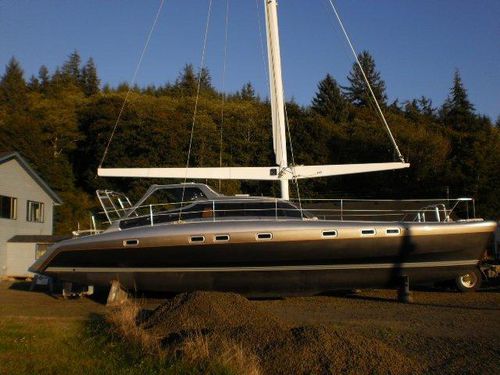
Characteristics
15.85 m (52'00" )
Description
Other pedigree cats products, sail catamarans 60' - 105'.
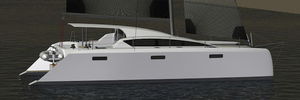
- Open sailboat
- Cruising sailboat
- 3-cabin sailboat
- 4-cabin sailboat
- Sailboat with enclosed cockpit
- Custom sailboat
- Flybridge sailboat
- Motorsailer sailboat
- 6-cabin sailboat
- New Sailboats
- Sailboats 21-30ft
- Sailboats 31-35ft
- Sailboats 36-40ft
- Sailboats Over 40ft
- Sailboats Under 21feet
- used_sailboats
- Apps and Computer Programs
- Communications
- Fishfinders
- Handheld Electronics
- Plotters MFDS Rradar
- Wind, Speed & Depth Instruments
- Anchoring Mooring
- Running Rigging
- Sails Canvas
- Standing Rigging
- Diesel Engines
- Off Grid Energy
- Cleaning Waxing
- DIY Projects
- Repair, Tools & Materials
- Spare Parts
- Tools & Gadgets
- Cabin Comfort
- Ventilation
- Footwear Apparel
- Foul Weather Gear
- Mailport & PS Advisor
- Inside Practical Sailor Blog
- Activate My Web Access
- Reset Password
- Pay My Bill
- Customer Service

- Free Newsletter
- Give a Gift

How to Sell Your Boat

Cal 2-46: A Venerable Lapworth Design Brought Up to Date

Rhumb Lines: Show Highlights from Annapolis

Open Transom Pros and Cons

Leaping Into Lithium

The Importance of Sea State in Weather Planning

Do-it-yourself Electrical System Survey and Inspection

Install a Standalone Sounder Without Drilling

When Should We Retire Dyneema Stays and Running Rigging?

Rethinking MOB Prevention

Top-notch Wind Indicators

The Everlasting Multihull Trampoline

How Dangerous is Your Shore Power?

DIY survey of boat solar and wind turbine systems

What’s Involved in Setting Up a Lithium Battery System?

The Scraper-only Approach to Bottom Paint Removal

Can You Recoat Dyneema?

Gonytia Hot Knife Proves its Mettle

Where Winches Dare to Go

The Day Sailor’s First-Aid Kit

Choosing and Securing Seat Cushions

Cockpit Drains on Race Boats

Rhumb Lines: Livin’ the Wharf Rat Life

Re-sealing the Seams on Waterproof Fabrics

Safer Sailing: Add Leg Loops to Your Harness

Waxing and Polishing Your Boat

Reducing Engine Room Noise

Tricks and Tips to Forming Do-it-yourself Rigging Terminals

Marine Toilet Maintenance Tips

Learning to Live with Plastic Boat Bits
- Sailboat Reviews
- Sails, Rigging & Deck Gear
A Practical Look at Sailboat Cockpit Design
Ps outlines what to look for when searching for a comfortable, functional cockpit..
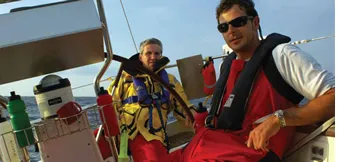
Cockpit ergonomics involve more than a concern about coaming angles and comfortable seating. These are just two items on a long list of attributes that define the space where sailors spend most of their waking time.
At boat shows, the crowd can be divided into those that poke around on deck and those who head directly below. Brokers know the difference between racing sailors and cruisers and which end of the companionway ladder will seal the deal. Racers want performance and scrutinize the on-deck design features that make it all happen, while cruisers look below for the amenities of a house afloat. This stereotype may be too rigid, but from what we’ve seen at recent boat shows, cruisers need to take a closer look at the cockpit and get a feel for how a sailboat will handle underway, as well as serve as a home away from home.
There’s much more at stake than comfort for the crew. Cockpit design and layout drives many boat-handling tasks, ranging from steering and sail trimming to what goes on when its time to reef. Angles of view can even affect watchkeeping.
For example, a high center cockpit and a large overlapping genoa create a 90-degree-plus no see zone, and thats a big deal when it comes to collision avoidance. A large catamaran with a tall bridge-deck cabin can add an even larger no see zone, especially when running on autopilot with no one perched on the elevated helm seat.
In short, many cockpits are optimized for at-anchor enjoyment instead of underway usability. So part of the boat-shopping process should include careful scrutiny of how essential sailing and boat-handling tasks will be accomplished. For starters, note how much contortion it takes to really crank each winch, determine whether or not the line leads favor easy reefing, and check to see how well the cockpit shape contributes to keeping the crew from being washed overboard. These are essential attributes, and for some, they are more vital than galley counter material and the fabric that covers the cushions below.
Grand Prix racers have long favored wide open, low sided, no-transom cockpits that are more of an open deck than a protective trench. In heavy weather, these nothing-to-cling-to cockpits can become perilous. In 1997, during the Hong Kong to Osaka, Japan Race, Americas Cup trials veteran Makoto Namba was at the helm of Escape One when a 20-foot breaking sea washed him out the open transom of the 45-foot racer. In 2006, Dutch Volvo Ocean racer Hans Horrevoets was swept from the deck of ABN AMRO TWO and lost at sea. Closer to home, pro sailor Dan Cianci was tossed over the lifelines of the 50-foot ocean racer Snow Lion. The accident occurred at night, in heavy weather just off the Delaware River mouth. In each case, the cockpit design favored sail trim and line handling over heavy-weather safety considerations. Many ocean racers mitigate such design tradeoffs with careful use of harnesses, tethers, jack lines, and hard points for tether attachment.
Just the opposite design trend can be found in the deep cockpit and conventional closed transom of sailboats such as Ted Hoods 25-year-old design, American Promise. Dodge Morgan sailed the heavy-displacement 60-footer solo around the world. The big, double-head rigged sloop provided a great deal of crew protection and seakeeping ability during Morgans voyage. And for years after he donated the boat to the U.S. Naval Academy, midshipmen also learned to appreciate the cockpit layout-particularly during bad weather offshore.
PS Technical Editor Ralph Naranjo sailed that boat in a gale-strewn trans-Atlantic with an able crew and encountered a nasty 979-millibar low at about 45 degrees North latitude. According to the log, AP was reaching eastward at 9 knots under storm trysail and storm jib with green water routinely sweeping the deck. Seas had silenced the mini-M satphone by regularly immersing the dome shaped antenna in wave faces, eventually flooding the internal circuitry.
It was a rough passage, and little things taken for granted in smoother seas showed their true value. Features like the deep cockpit well, the heavy-duty, water-tight companionway doors, and the massive cockpit drains all proved their worth.
The flip side of the coin is that really bad weather encounters are a rare occurrence for most sailors. More often, 0- to 20-knot sailing conditions prevail. And our coastline is dotted with safe havens in which to hide from the elements. So one of the big challenges facing every designer and naval architect drawing lines for their next new boat is the question of exposure. Will owners use the boat as a dockside second home and be underway only in fair weather, or will they take the cruiser label to heart and leave land well astern? A close look at cockpit layouts will give you some indication of the boats intended use.
We prefer to evaluate cockpit ergonomics from both static and dynamic points of view. On some boats, these underway and at anchor evaluations lead to disparate conclusions. A cockpit that works well underway may be confining in port, or another vessel with a patio-size stern may be altogether dysfunctional at sea. It’s all an issue of trying to do two different jobs with one fixed set of dimensions and appendages. Buyers need to know what attributes they will make best use of.
For monohulls, coping with heel is the first big challenge, and wide-open space, whether its in the cockpit or main saloon, can be a tough challenge. The universal solution to carrying wide beam aft on cruising boats seems to be the ubiquitous cockpit table. It can be a handy centerline support, but it’s a tough addition to a seafaring cockpit in the minds of many traditional sailors. That said, production boatbuilders have gotten much better at making these centerline, folding-leaf tables sturdy enough for sea duty and effective as a handhold.
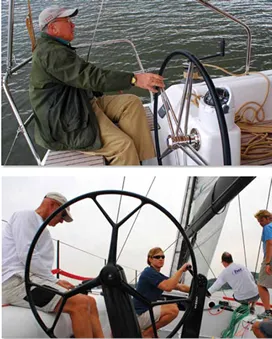
Industry Trends
Over the last 50 years, mainstream production sailboat design has moved noticeably away from the racer/cruiser defined by Pearson, Tartan, C&C, Cal, Columbia, Ranger, Islander, Ericson, and others. The new boats are roomier with less emphasis on performance under sail. Racers now have their own genre of sailboat, and they are faster, better handling, and more capable than their predecessors. But whats most surprising is that many mainstream cruisers are anything but optimized for long-distance passages and long-term living aboard.
These boats feature convenience, style, and comfort, and the actual design objective in many cases is more focused on weekend cruising and an annual two-week summer harbor-hopping cruise. Easy sail-setting and large boat interiors in shorter waterline lengths prevail, and such trends influence the shape and layout of the cockpit. When it comes to ergonomics, the split between cruisers and racers is more apparent than ever, but theres also some real differentiation within the ranks of cruisers themselves.
In Practical Sailors recent scrutiny of cockpit designs at local boat shows, weve noted four emerging sailboat stereotypes. These include daysailers that feature few, if any, accommodations; racing boats brimming with performance-enhancing hardware; and ocean-going cruisers capable of extended passagemaking. The fourth grouping-larger than all the other three combined-are also labeled cruisers, but with less draft, less stability, and less versatile sail plans, they are more like an SUV designed more for the highway than off-roading in the backcountry.
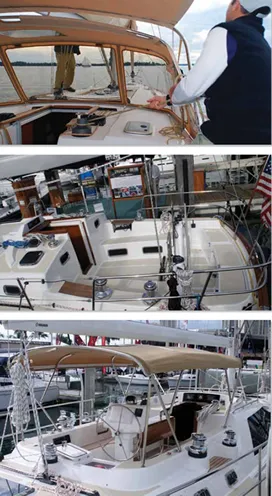
Sizing Up a Cockpit
The takeaway lesson for us was the importance of making sure that the cockpit of the boat you are about to buy is in keeping with the mission of the rest of the boat. If you are a serious club racer, the centerline table wont be a crew favorite. Those making a double-handed passage on a 40-footer will see a tight, narrow cockpit differently than when eight sail the same boat. So with complete belief in the old adage, different strokes for different folks, heres what we looked for when evaluating cockpit design. It can be used as a helpful buyers guide when you’re surveying your next boat.
Working the winches: All too often, winch location is an afterthought, and fine hardware is stuck on side coamings shaped more as a roof for the aft cabin than as a key component of sail trim. We always like to check sheet leads angles that lead lines to a particular winch and then mimic what cranking with a two-handed winch handle would be like. Look for 360-degree clearance with no knuckle-busting stanchions in the way. Be sure that the winch grinding works on either tack. Genoa sheeting may always put you on the leeward side of the cockpit, but runners and spinnaker guys will usually be worked on a windward winch.
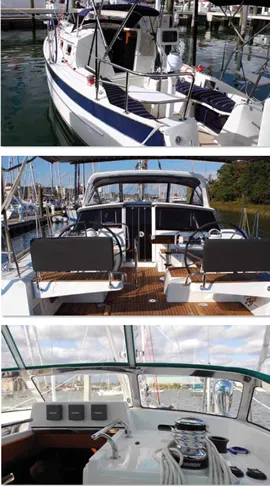
Sheets and halyards: One of testers major complaints was builders habit of running seldom-used halyard lines attached to roller-furling headsails and in-mast furling mainsails all the way aft to the cockpit. Doing so left lengthy line tails cluttering up the area under the dodger where reefing lines, the boom vang, and in some cases, the main sheet all arrived like too many trains in a station.
Theres no perfect mainsheet arrangement, but some are better than others, and the one you choose has a lot to do with how much attention you pay to the nuance of sail trim. The current vogue among serious racers involves 2-to-1 end-boom sheeting: an in-boom lead of the double-ended sheet returns aft via turning blocks near the mast and runs to winches on both sides of the boat (often referred to as Admirals Cup, or German mainsheet). Fast, no-load hand trimming is the upside, but in any breeze, theres good reason to quickly get the sheet on a winch drum. The sheet tail is shorter because of the low ratio (2-to-1) lead. One nuisance is that the sheet can end up bunched up on one side or the other.
Many cruisers prefer higher ratio, multi-part tackles for mainsheeting and may lead each end to a Harken-type adjustment system rather than using a winch. When fast tacking action is not in the cards, this is a user-friendly system.
Some cruisers incorporate mid-boom sheeting because it moves the tackle out of the cockpit than rather then because of how effectively it allows the mainsail to be trimmed. The shortened lever arm means the sheet needs a winch sooner than later. There is also more of a leech-flattening, vang-like effect to this type of sheeting, not the best feature for light-air efficiency.
The trend toward travelers roosting on over-cockpit arches, a longtime standard in Hunter Yachts and a recent adoption in some Beneteau lines, helps protect the crew from accidental jibe injuries and allows dodgers and biminis to flourish, but windows in these covers are essential, if a crew is to see whats happening whey they are pulling the strings.
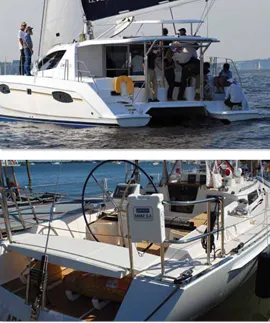
Anticipate the angles: Look at how things will change as heel increases and note where vulnerability lies. We recently ran into a crew who had lost an engine due to the shape of the cockpit. During the design phase, the location for an engine instrument recess was placed within easy reach of the person at the helm. In an upright trim-and even at 30 degrees of heel-all was well, but in a knock down when the cockpit began to flood, the engine instruments ended up in a low spot, and despite their sealed all-weather design, submerging them in saltwater had not been part of the engine manufacturers gameplan. The ensuing corrosion took out the panel and the alarm system, and a novice crew failed to notice the changes in sound and smell as a raw-water blockage in the cooling system went critical.
Those headed offshore need to pay special heed to the companionway and have a feel for what angle of heel sends water down an open hatch. Whats a surprise to many is that the first part of the hatch to reach the water may be the top rather than the lower portion of the companionway. Sticking in a washboard or two will help keep a breaking wave from sloshing below, but it may be of little use in a deep knockdown.
Getting in and out: One of the most important safety features of a good boat is the transitional path that leads a crew from the cockpit to the deck. Good engineering focuses on step heights, deck camber, handholds, and the quality of the nonskid surface. This transition in and out of the cockpit is one of the most repeated movements on the vessel. If a dodger, bimini, or Florida room compromises access, they become a hazard. Small, molded steps are of little help in a seaway.
There is no ideal cockpit that meets everyones preferences, and plenty of bad ideas still persist. No matter what your aims are as a sailor, some things deserve to take precedence. Ample space for entertaining friends for sundowners dockside is nice, but comfort underway, including ergonomic seats for sitting or napping, and secure places to steer and stand watch when the boat is heeled should be a higher priority.
Likewise, sight lines and sensible sheet arrangements should come before drink-holders. Next time you prowl the boat show, spend some time exploring the cockpit and comparing features. It is the hub of the boat.
Rating cockpit attributes is a worthwhile endeavor for a serious boat shopper. Start by rating component parts. It will allow you to more effectively compare and contrast one boat with another, according to your specific sailing plans and needs.
For example: Above, we have focused on seven key cockpit attributes and rated five new boats accordingly. Below is a brief explanation of each of the criteria selected. The result of the data table is not a winner-take-all report card. It’s a means of determining what has been emphasized in a specific cockpit design on a wide variety of very different vessels.
Rating for this attribute reflects both the location of a winch and the way in which crew members must bend, lean, or contort themselves while sheeting. We considered how efficiently a manual winch could be cranked and whether or not an electric winch could be safely operated while retaining a clear view of the sail being sheeted or hoisted.
This was not a look at the vessel’s steering hardware, rudder design, or feel of the tiller. It was more focused on helm location and how the person steering the boat could carry on the process comfortably for lengthy periods of time.
We consider the ability to quickly and efficiently reduce and add sail area to be a primary aspect of seamanship. Cockpit layouts teamed up with efficient well-chosen hardware can make or break this facet of cockpit ergonomics. Awkward winch placement, too many lines clustered together around a big bank of rope clutches, and attempting to place sheets, halyards, and reefing lines all in the helmsman’s lap with only one or two undersized winches usually lead to lower ratings.
Collision avoidance requires seeing what’s about to cause trouble well ahead of time, and anything shy of a 360-degree angle of view detracts from the process. We were concerned about view angles and obstructions ranging from dodgers, to deck-sweeping headsails, cabinhouse bulkheads, and other design features that limit the helmsperson’s field of vision. Aboard many multihulls, there’s a growing trend toward providing one perch that offers an all-around view. But when the vessel is operating on autopilot and no one is in the elevated helm seat, watchkeeping efforts are hampered.
When floating on an even keel, it’s easy to get in and out of most cockpits. However, a modest heel of 15 degrees can turn wide-open cockpits with awkward coamings and narrow sidedecks into a hazard. Getting around on a vessel in a seaway requires good nonskid, an abundance of ready handholds, and an unobstructed pathway in and out of the cockpit. Seats need to be usable underway, and the dodger, companionway, and bimini must work in concert.
Short Handing
Because most cruisers sail short-handed, we are always on the look out for features that make watchkeeping more user friendly. These include line leads and winch layouts that allow headsail trimming from the helm and may even offer the chance to tuck or shake a reef from the confine of the cockpit. Crew alone on deck also benefit from deeper-welled open space. Giving the short-handed crew protection from seeping seas and offering well-placed hardware goes a long way to ensure safe, efficient passagemaking.
Entertaining
At anchor and in port, the cockpit changes from an operations center to a backyard patio. Gone is the need for seakeeping attributes, and what counts is how well the area at the aft or center portion of the boat stacks up as a place for stationary fun. Tables that can serve dinner for six or drinks for 10 get high marks. Transoms that fold down, offering access to the sea, are also a current rage. It’s no surprise however, that many of the attributes that drive high scores for entertaining earn a lower grade at sea—the reason many designers and builders have spent time developing fold-up swim platforms and wellreinforced drop-leaf tables ready for sea duty.
VALUE GUIDE: Comparing Cockpit Design
Related articles more from author, leave a reply cancel reply.
Log in to leave a comment
Latest Videos
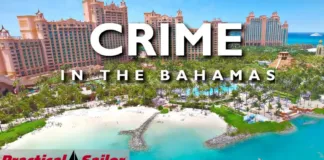
Bahamas Travel Advisory: Cause for Concern?

Island Packet 370: What You Should Know | Boat Review

How To Make Starlink Better On Your Boat | Interview

Catalina 380: What You Should Know | Boat Review
- Privacy Policy
- Do Not Sell My Personal Information
- Online Account Activation
- Privacy Manager
World Renowned Reputation - The UK's Premier Boat Cover Maker

WORLD RENOWNED REPUTATION THE UK’S PREMIER BOAT COVER MAKER

Cockpit Enclosures - Catamaran
Make the most of your liveaboard space and enclose your cockpit.
Lagoon Power 43 Cockpit Enclosure
Performance, Longevity and Great Design are keywords here at Tecsew
Privilege 435 Cockpit Enclosure
Tecsew supply many leading UK boat importers, Boat Builders and Private Clients
Lagoon 380 Cockpit Enclosure, Hard Top Version
We can dispatch to most of the UK, Europe and Scandinavia
Lagoon 380 Cockpit Enclosure, Soft Top version
Top quality, well engineered proven designs. Order now!
Catalac 9 Mtr Catamaran Cockpit Enclosure
Tecsew should be your first choice when it comes to selecting a classy Catamaran Cockpit Enclosure. With our flair for design, we will endeavour to create a product that surpasses your expectations, and offer advice at the crucial design stage.
Bespoke design is our speciality and we will always listen to your requirements. We believe that with our in-house 3D computer-aided design (CAD) system, we can meet and surpass your expectations, and coupled with our use of premium brands, Tecsew will ensure a top-quality product.
Once engaged on a commission, we will develop a 3D CAD design and supply renders (virtual photos of the CAD model) for your approval. We take these steps to ensure that the Catamaran Boat Enclosure you envisage comes to fruition when presented in actuality.
Leading Catamaran Enclosure Designers
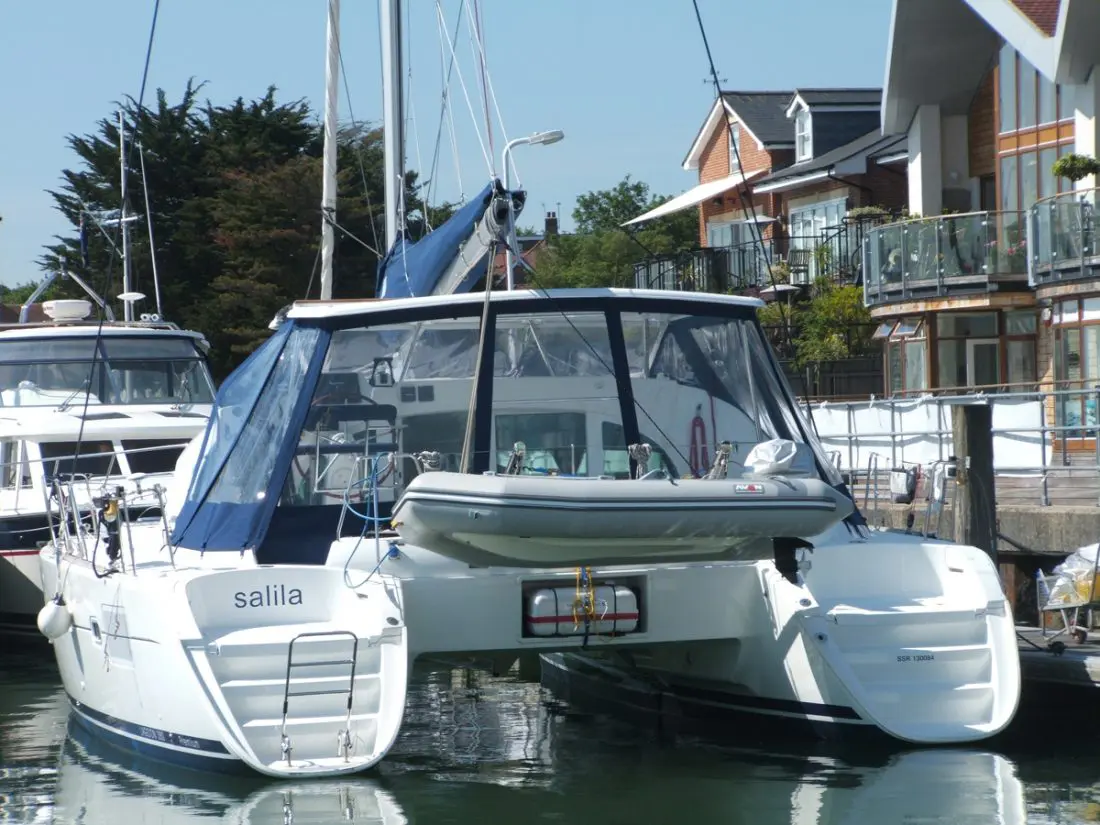
We also hold many standard designs that have been developed for and supplied to major UK boat importers, including popular brands Hanse, Bavaria, Jeanneau and Beneteau.
Good design is vital when it comes to creating a product that is both efficient and fulfils your requirements. Our 3D CAD design process and use of industry-leading brands such as Sunbrella Plus canvas and YKK zips enable us to produce a superior Cockpit Enclosure that can withstand the harsh elements in the toughest marine environments.
Our Cockpit Enclosures are fully functional together with a high-quality specification that you will find hard to better. They are effective in offering protection to both the Cockpit and your crew and vastly increase your liveaboard space. When you wish to fold and pack your Tecsew Cockpit Enclosure away, for the time being, you’ll want to do so in a way that ensures its integrity. Watch our demonstration video, ‘Cockpit Enclosures, How to Stow’ to learn more about this.
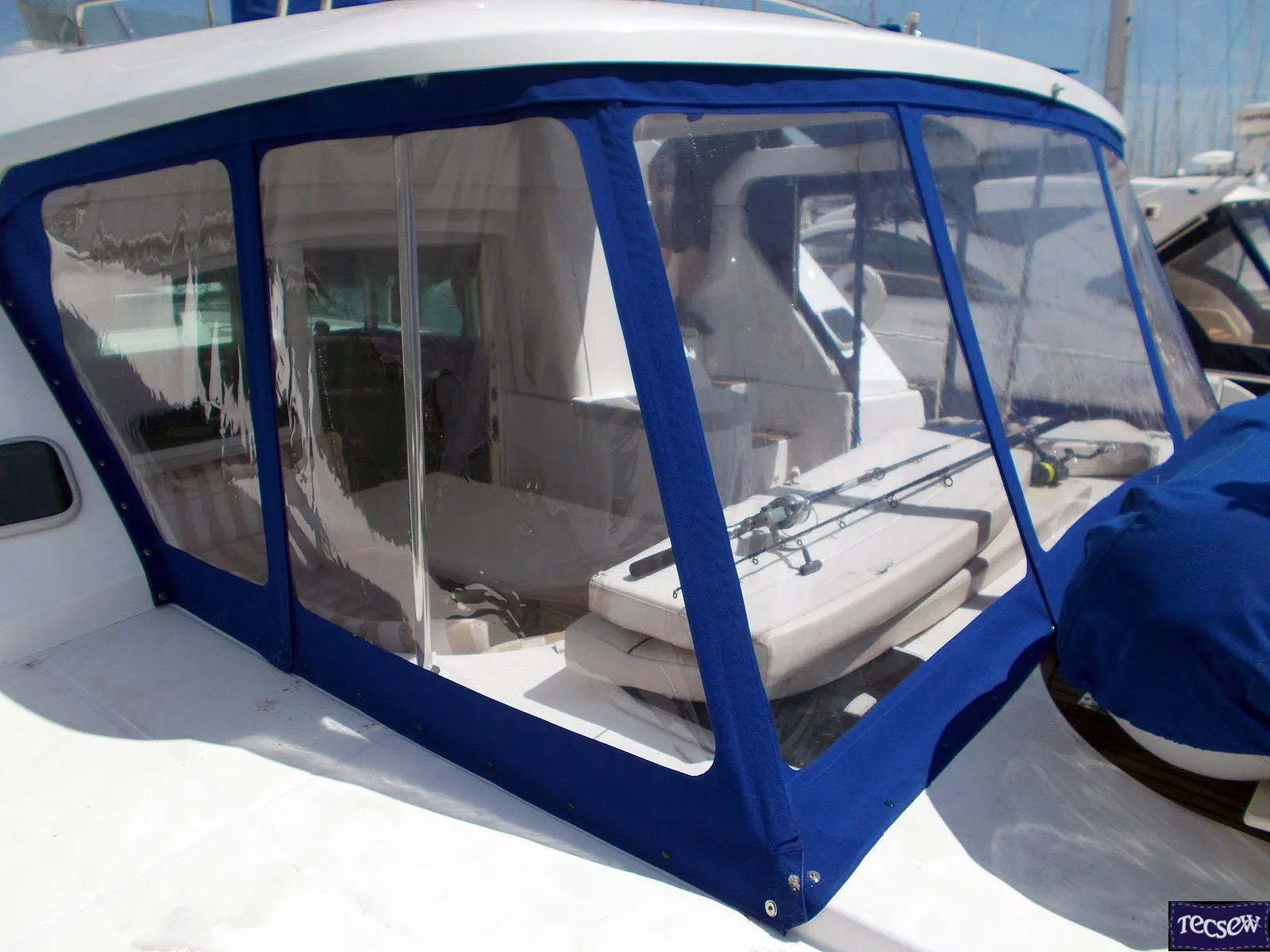
Choose Tecsew for your Catamaran Cover Accessories
All our Catamaran Cockpit Enclosures are designed as premium products and can be further enhanced with the addition of optional extras such as window blinds. The Enclosures come in a wide variety of colours and specifications to suit both your personal preference and boat features.
We take pride in ensuring accurate production to come up with reliable and functional boat canvas and accessories. Nearly all standard designs are available for self-fitting and we export to Europe, Scandinavia and the Far East.
Why not check out examples of our Catamaran Cockpit Enclosures in the gallery below or use the search function.
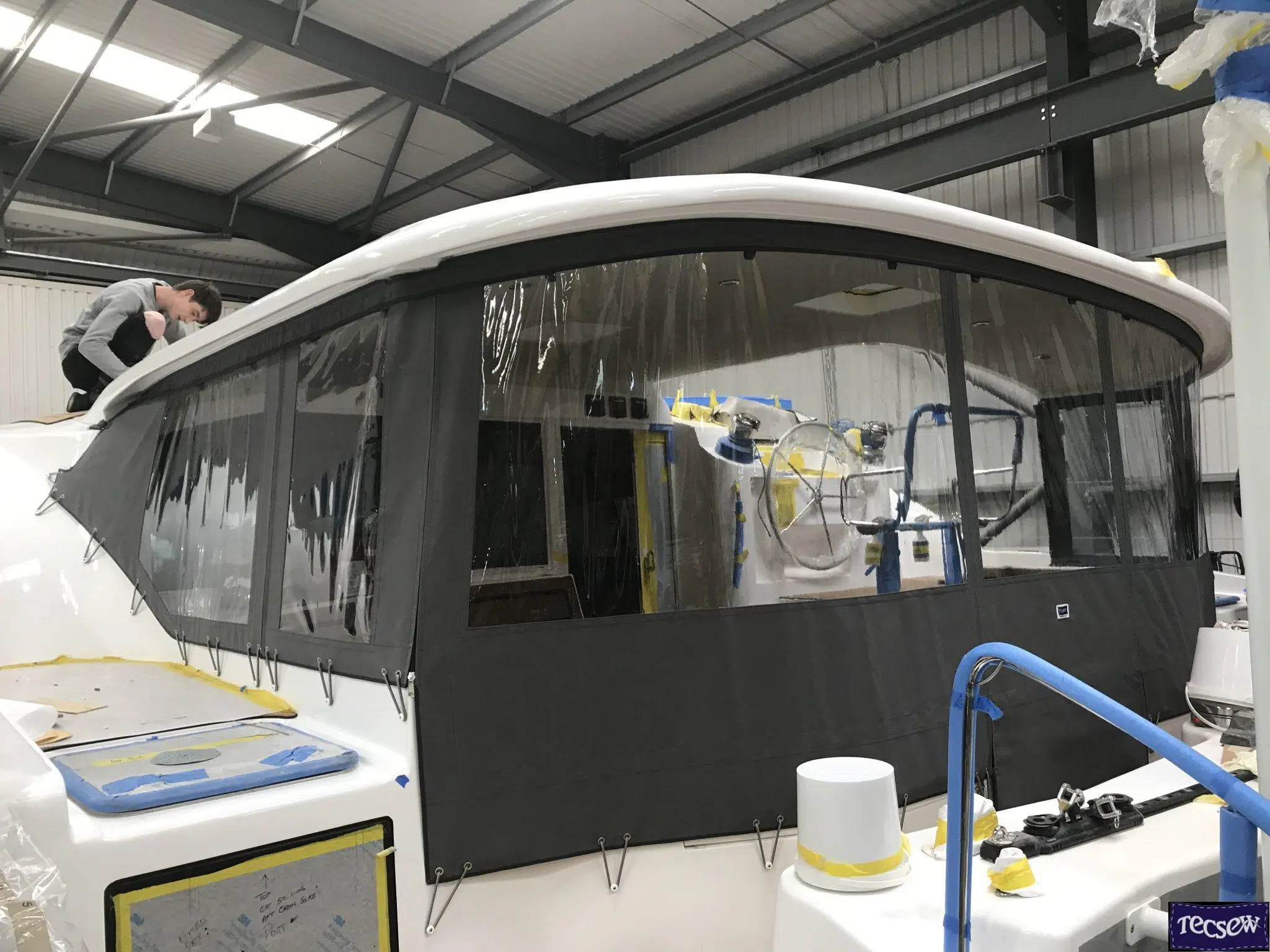
Call us for enquiries on 02392 556548, visit our contact page , or use the enquiry form at the bottom of the page. Our friendly staff will gladly assist you.
Cockpit Enclosures - Catamaran Gallery
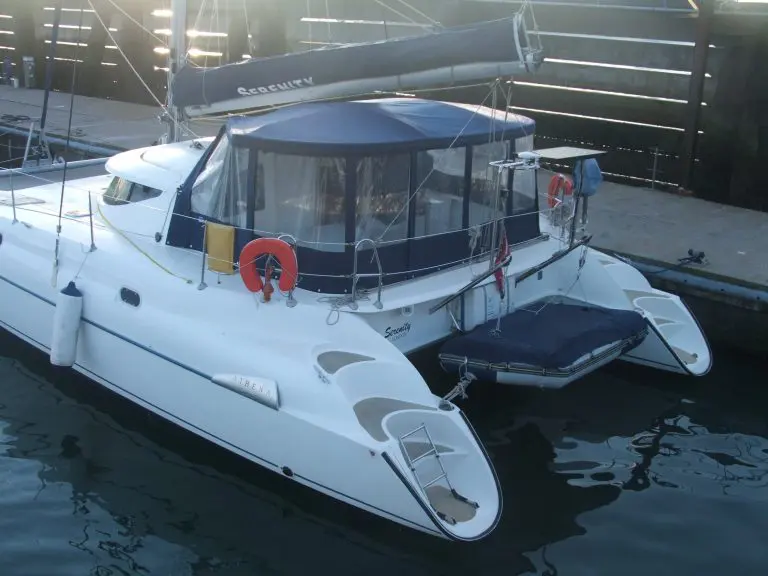
Athena Catamaran Cockpit Enclosure, Serenity
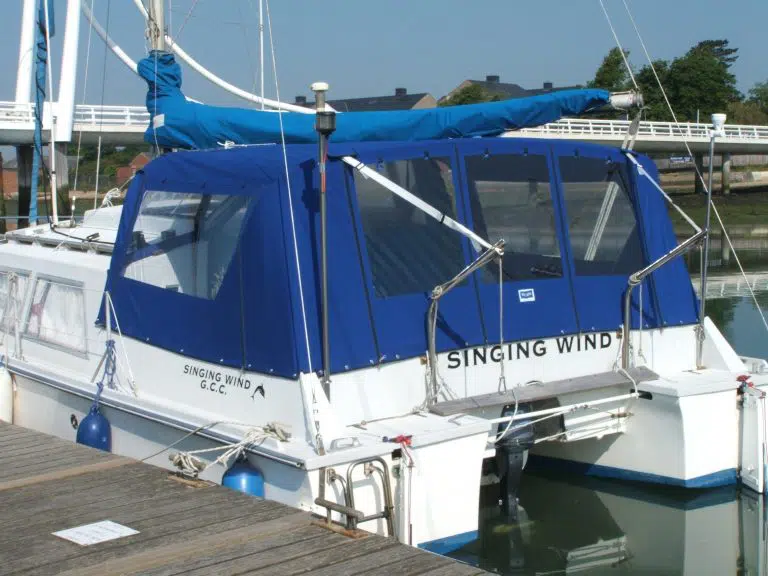
Catalac 8mtr. Cockpit Enclosure
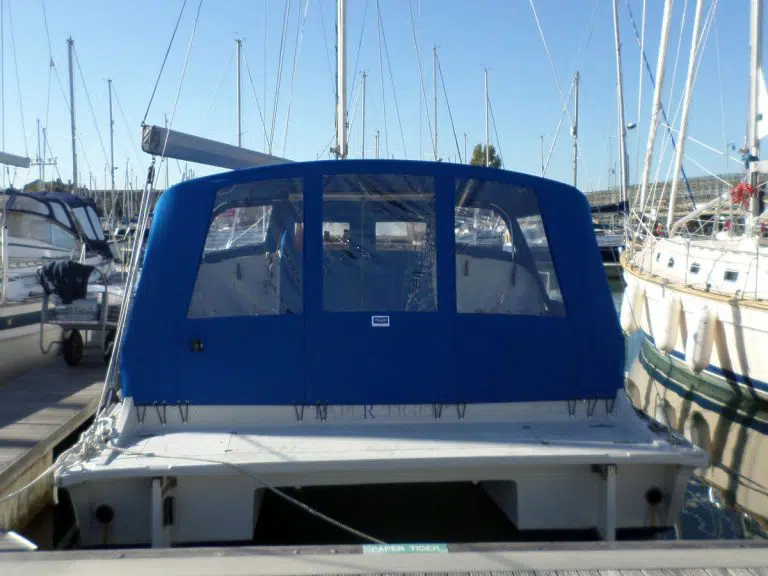
Catalac 9 Mtr, Paper Tiger, Cockpit enclosure, ref 6575
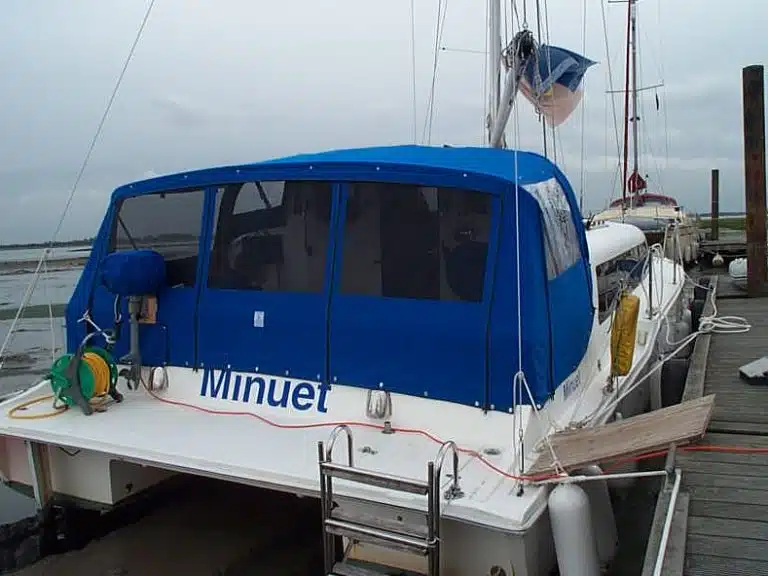
Catamaran, one off design, Cockpit Enclosure
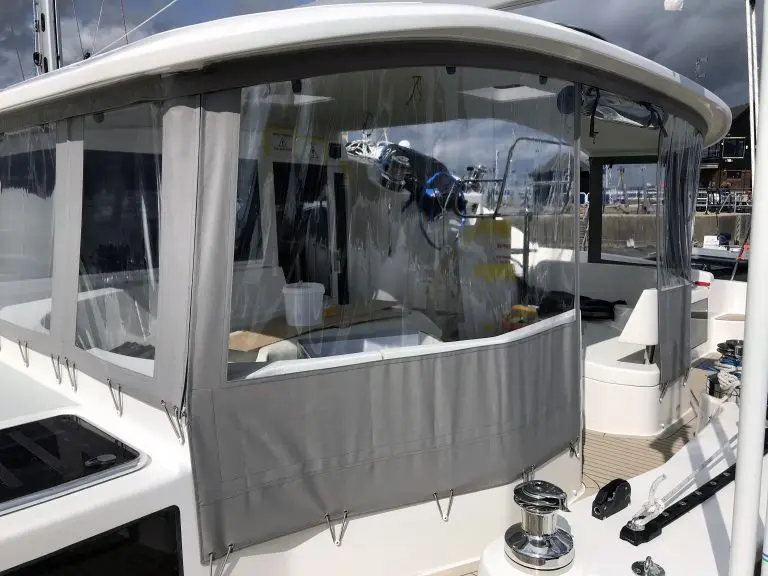
Discovery CAT 50-005 Cockpit Enclosure, ref 9333
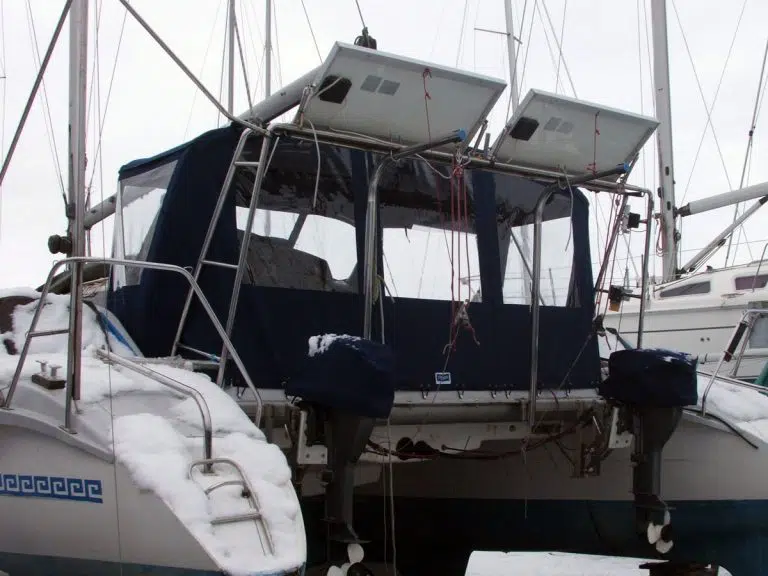
Edel 35 Cockpit Enclosure and Sprayhood
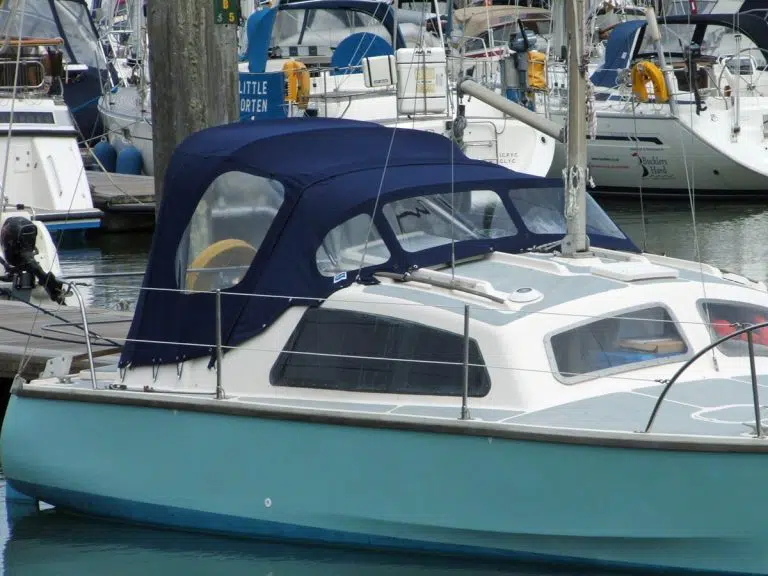
Hirondelle Catamaran, Harmony Cockpit Enclosure
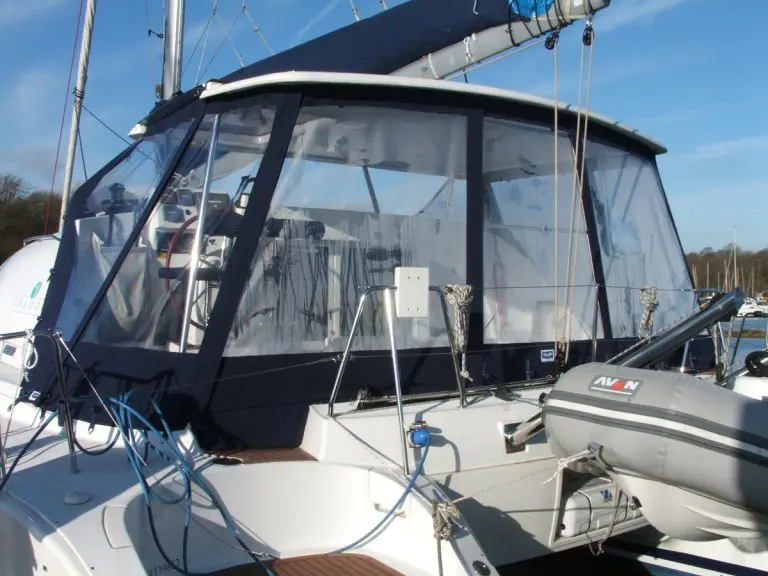
Lagoon 380 Cockpit Enclosure
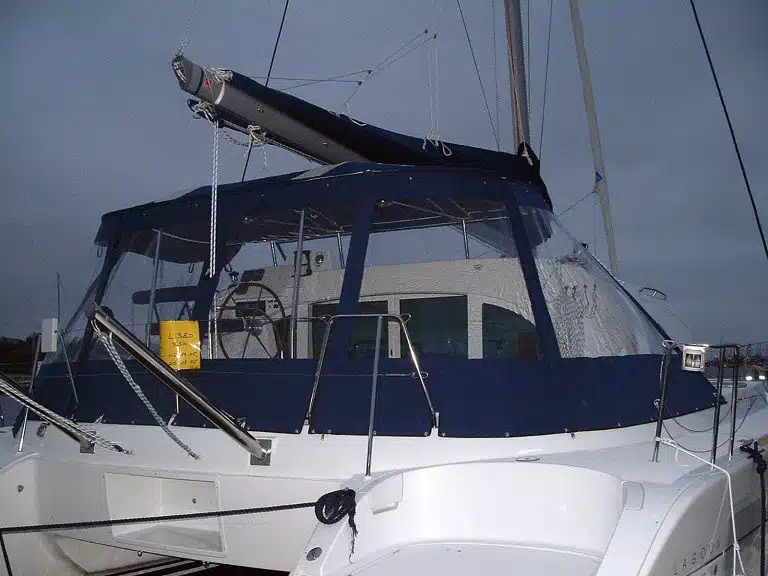
Lagoon 380, Bimini Conversion, Design 1
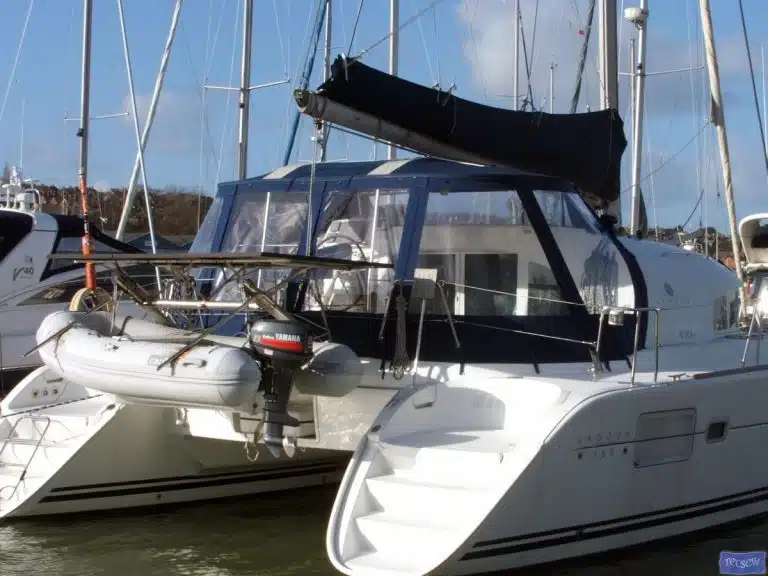
Lagoon 380, Bimini Conversion, Design 2, ref Gira
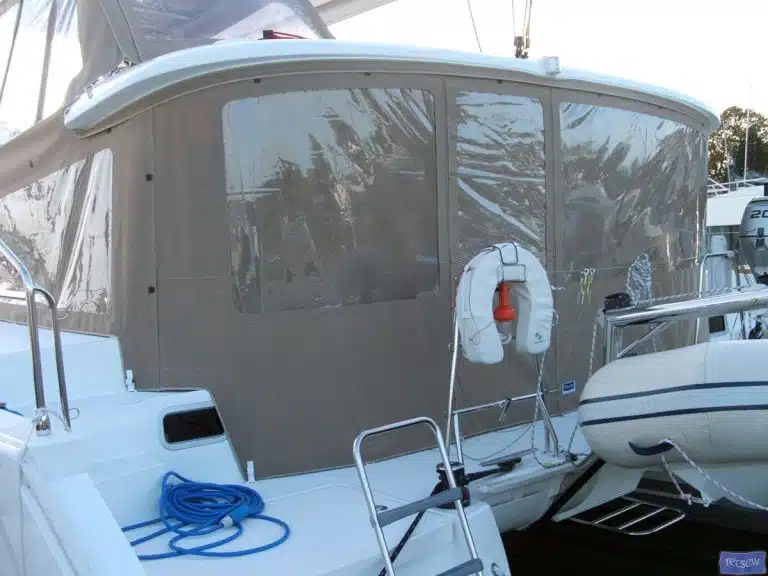
Lagoon 400 Cockpit Enclosure With Internal Window Blinds
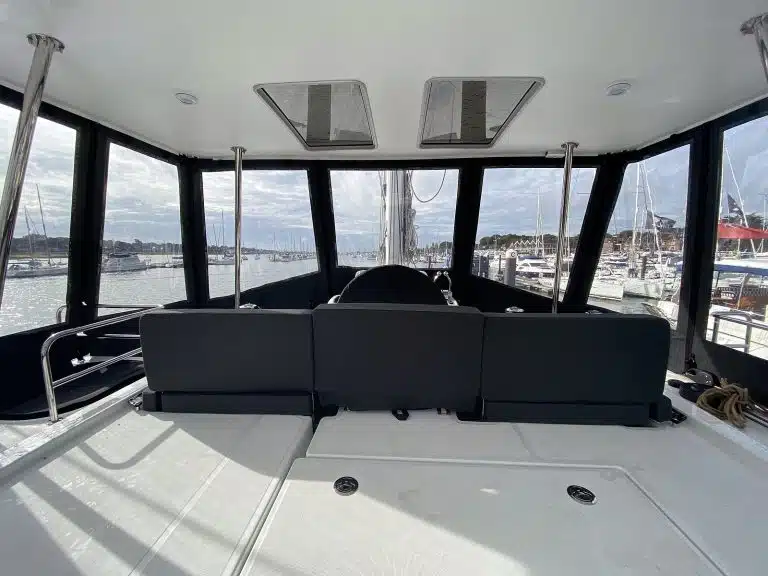
Lagoon 50 Solar Hard Top Enclosure, ref 0954
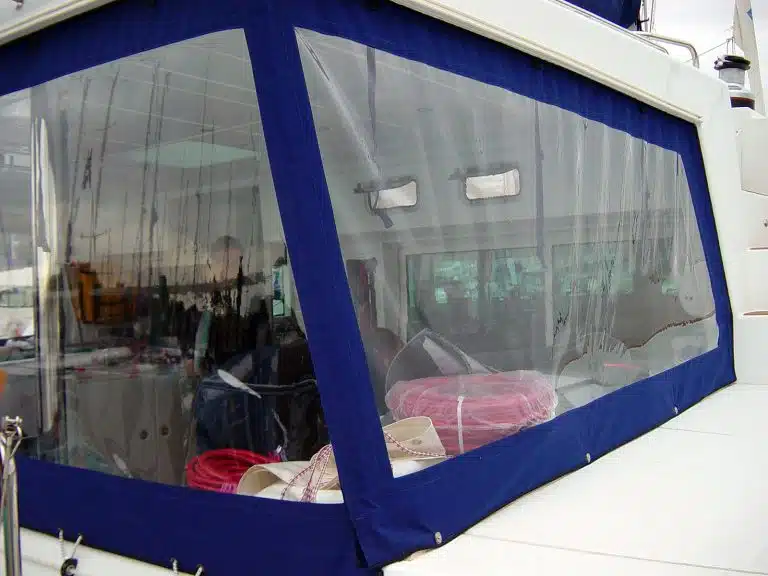
Lagoon 500 Cockpit Screens
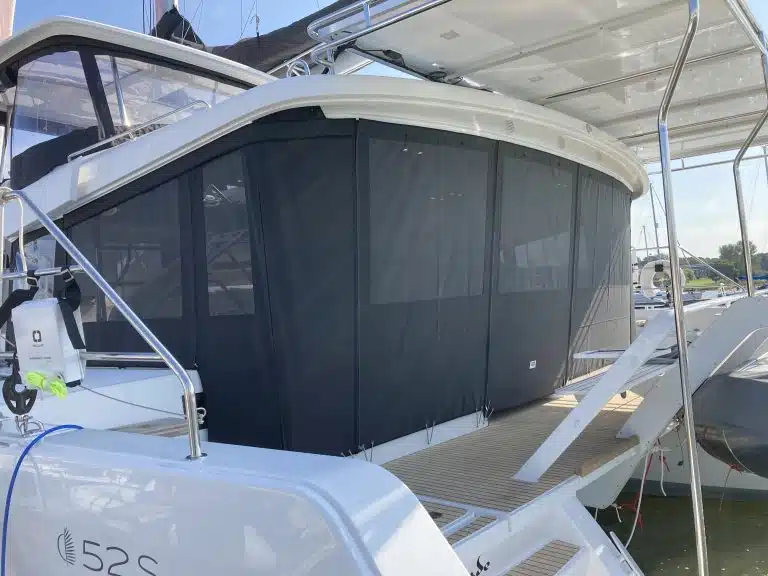
Lagoon 52S Cockpit Enclosure with Soltis 86 Mesh Windows, ref 0231
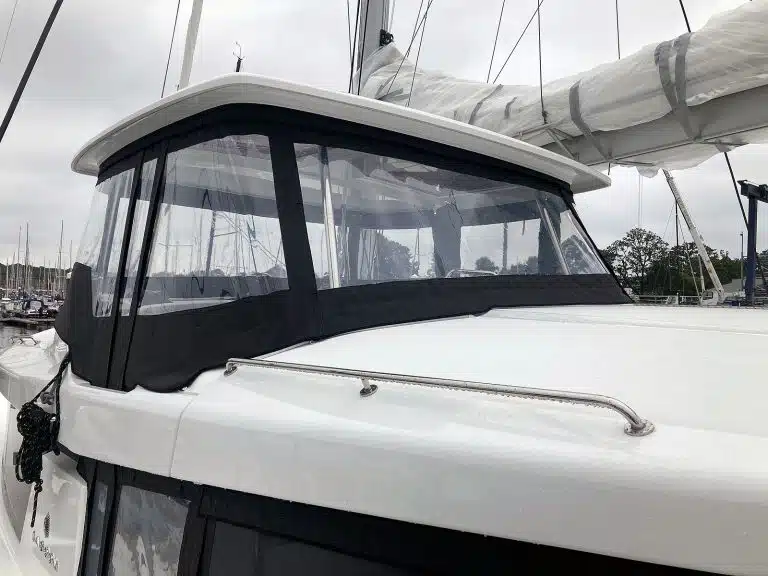
Lagoon 52S Helm Enclosure, ref 0231
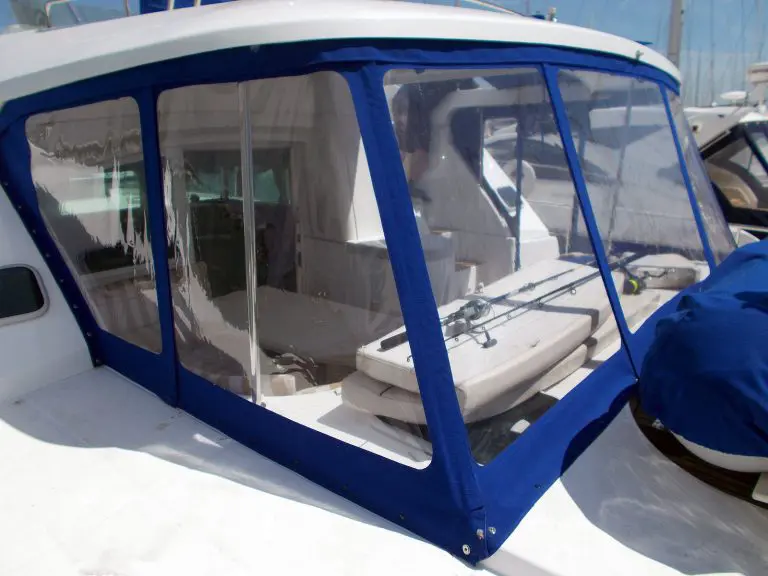
Lagoon Power 43, TOPCAT, Cockpit Enclosure, ref 8896
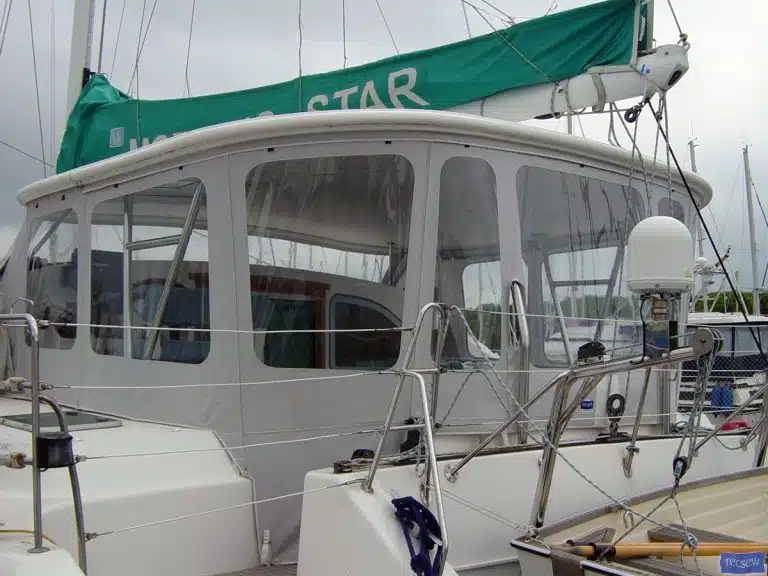
Privilege 435 Cockpit Enclosure, Morning Star
Have a question we are happy to help.
02392 556 548
Tecsew Ltd, Unit E3 Eagle Building Daedalus Park, Daedalus Drive Lee-on-the-Solent, Hants, PO13 9FX
- Name * First Last
- Yacht/Powerboat Type *
- Your Boat Image Accepted file types: jpg, png, jpeg, Max. file size: 32 MB.
- Ask a question *
- Name This field is for validation purposes and should be left unchanged.

COMMENTS
Some well-designed catamarans between 25 and 39 feet in length can also be used. A good liveaboard cruising catamaran should have adequate berthing and galley facilities, along with an enclosed cockpit. Catamarans without enclosed cockpits, especially smaller vessels, aren't spacious enough in the hull to accommodate good liveaboard facilities.
Enclosed Cockpits. Bluewater catamarans virtually always have an enclosed cockpit. Not only does this shield you from the sun in winter, but the elements in winter making cruising far more comfortable. ... The enclosed cockpit makes sailing safer, plus of course, when you need to get out on the deck, the stable catamaran is not pitching and ...
The Longreach Expedition is a variation on the regular LR58, but with a vastly different and innovative layout. Featuring a fully enclosed flybridge and fully enclosed cockpit that can be opened up with electric windows. The internal living space is huge starting with a massive galley forward and shared living spaces between the saloon and cockpit.
The entire boat has been refined to integrate the latest features, technology and performance that HH Catamarans is known for. On the interior, the layout has been improved to feature a more social layout with twin, L-shaped sofas, seating on all four sides of the cockpit, a more modern island galley, and large forward opening salon windows improve ventilation throughout the boat.
HH66-SCF (Forward Helm) Version: Far from ordinary, the HH66-SCF (Forward Helm) was created to emphasize the pure joy of sailing. The forward cockpit increases the ease of line handling and passage making, while the optional aft tiller chairs with push button controls of the Mainsheet, Traveler, Cunningham and Daggerboards create a sailing sensation few will ever get to experience.
A spacious aft cockpit area that can be upgraded and customized to suit your own particular design needs High bows and curved forward crossbeam make for a streamlined appearance; Room for three cabins and two heads. The owner's cabin has its own en-suite bathroom with a large shower. Glass-enclosed cockpit
The 220-horsepower Volvo Penta D3 is mounted just abaft the salon bulkhead and reduces noise levels to make the C100 exceptionally quiet under way. The spacious cockpit is designed for fishing or entertaining with standard features including a refrigerator and a sink, a built-in, 96-quart Igloo cooler with a large seat, and generous stowage in ...
The HH60-SCF is the same boat as the SC, but features a forward cockpit and optional aft tiller chairs. This lowers the boom, reduces weight and increases sail area (and performance). It also makes room for an industry leading 5,774 watts of solar on the coachroof and davits. Better by design.
cruising 4-cabin with enclosed cockpit. Overall length: 12.19 m. Fusion Catamarans will produce again in 2024 the easily driven Fusion 40 in either a Power Boat or Sail Boat configuration. The Fusion Sailing Catamaran is designed to satisfy the Charter industry requirements, yet provide a highly economical ...
Cockpit settees have adjustable recliners on port and starboard; Cockpit engine controls; Large storage areas below cockpit floor; Dodger, bimini, fully enclosed cockpit with Lexan panels Cockpit cushions with upgraded foam (2018, like new) Two deep storage lockers forward in each bow and abundance of storage below cockpit sole; Deck
Catalina 275. The boat is small, but the Catalina 275 still earns points for its spacious cockpit. It's easier to get a large cockpit on a large boat, but on the opposite end of the big cruising boat spectrum is the sporty Catalina 275. This sailboat builds a clever cockpit into much less space. Designer Gerry Douglas has always understood ...
The game hasn't just changed, it's been revolutionized. With the introduction of the 46' Catamaran in 2020, it raised the cat segment to a whole new level. Now we've upped the stakes again by unveiling the first-ever production pilothouse catamaran. Offering the same range, performance and 360-degree fishability of the center console 46 ...
The forward cockpit has a clear view of the sea. It can be closed off completely to protect the helmsman from the elements. The forward cockpit's fixed and sliding openings (side, ceiling, and front) offer an excellent view of the bows, sails, rigging, and the catamaran's foredeck. On top of this, the Windelo cockpit keeps the skipper ...
Photo: Leopard Catamarans. Displacement: 14.5 tons Beam: 24ft 2in Draft: 4ft 11in Features: Forward-facing cockpit, 3 or 4 cabins, 8 to 12 berths, up to 4 heads, up to 5 showers, 2 45hp engines, 780L water capacity, 700L fuel capacity. The big unique selling point of this best catamaran for sailing around the world is the forward-facing cockpit - a shaded and well-ventilated area to relax ...
The enclosed cockpit aboard the Antares is designed to protect you from the weather, and not just for cocktail parties (though that's never stopped us before)! ... The Antares catamaran is outfitted with a premium shaft and rotary gear steering system as opposed to cable or hydraulic steering. Another factor where safety is never compromised ...
Whether you are cruising, fishing or diving with over 45 square feet of cockpit space there is room to roam. Anywhere you wish to go — from the cold north to the tropics — the TomCat can take you there. And its performance is unparalleled. Tested for speed, fuel consumption, and power, the results show that this catamaran will never disappoint.
outboard cabin cruiser ST790 OBS. with enclosed cockpit sport-fishing 8-person max. Length: 7.9 m. Characteristic Data Overall length with motor: 7,90 m Length hull: 6,93 m Max Beam: 2,86 m Max displacement: 3,10 Tm Mono-motor: 150 a 250 cv Bi-motor: 2x 115 / 150 cv Fuel: 270 L Fresh water: 80 L Crew: 8.
The GUNBOAT 48 was a very successful Gunboat series from 2004-2009. Designed for family sabbatical cruising, the 48 series typically features three queen berths, a convertible office or 4th berth and two heads. The simple and informal accommodations are light and airy. The salon, helm and galley are located on the main deck within the pilothouse.
Owners' cabins are luxurious, airy, and spacious serving as a very comfortable living space, rather than just a place to sleep. 3. Wave-Piercing or Reverse Bows. Wave-piercing or reverse bows are considered cutting-edge naval architecture and one of the latest popular catamaran. design trends.
This model comes with an enclosed cockpit and air conditioning to keep you cool when cruising. The motors on this boat are monsters, featuring a twin setup of 550-HP Cummins diesel inboards available on the sports version for superior power and speed on the water while maintaining the boat's maneuverability.
This custom catamaran was designed by John Shuttleworth, a leading high performance catamaran designer from England. He was contracted to design a fast, smooth, safe cat that would support the newest idea of self sailing rigging, the AeroRig®. ... cruising with enclosed cockpit. catamaran Shuttleworth 63' cruising with enclosed cockpit custom ...
For example, a high center cockpit and a large overlapping genoa create a 90-degree-plus no see zone, and thats a big deal when it comes to collision avoidance. A large catamaran with a tall bridge-deck cabin can add an even larger no see zone, especially when running on autopilot with no one perched on the elevated helm seat.
Nearly all standard designs are available for self-fitting and we export to Europe, Scandinavia and the Far East. Why not check out examples of our Catamaran Cockpit Enclosures in the gallery below or use the search function. Call us for enquiries on 02392 556548, visit our contact page, or use the enquiry form at the bottom of the page.